Data Transformation: A Total Beginner’s Guide
When starting your career in data analytics or data science, you’ll find a lot of companies rely on many sources of data. Sometimes the data sources are stored in different formats or technologies. For example, the company I work for uses both SQL and NoSQL solutions making it difficult to join the raw data together.
Using data transformation techniques, it’s possible to bring the data out of their silos, reformat them and store them in a central location called a data warehouse.
In this data transformation tutorial, we will simulate working with SQL and NoSQL data by walking through the steps of transforming JSON data into tabular data in SQL Server. By the end of this article you’ll have learned the following about data transformation:
- What is data transformation?
- How does data transformation work?
- How to perform a data transformation
- The benefits of data transformation
- The challenges of data transformation
Feel free to use the clickable menu to skip ahead to any section. With that said, let’s get started!

1. What is data transformation?
At a high level, data transformation is the operations by which source data are formatted or reshaped to fit the constraints of downstream systems or processes. Data transformation is often considered a data engineering or data governance task, typically occurring in extract, transform, load or extract, load, transform (ETL/ELT) pipelines designed to process raw data.
These data transformation processes take extracted source data and add to it, delete from it, or format it before storing it. In large scale systems, data transformation is usually automated by software used for creating data warehouses and data lakes. However, on smaller scales, data analysts and data scientists oftentimes will need to perform data transformations manually so they can model the data to assist with data-driven decision making.
An explosion in the Internet of Things (IoT) or “smart” devices has resulted in an age of big data . The massive increase in data means it is more important than ever to efficiently process and store data in ways that make it easy to analyze. By creating pipelines and processes to transform their data, organizations ensure they’re able to extract insights.
To help illustrate data transformation in the ETL/ELT processes, we’re going to work through an example. Imagine you’re an analyst at a company that stores structured data via rows and columns in one database and unstructured data via JSON in another database.
In order to perform an analysis, you need to format the unstructured data so it can be joined with the structured data. Whether your process is based around ETL or ELT concepts, the transformation needs to take place so the raw, unstructured data ends up being compatible with the structured data.
Next, let’s look at how data transformation works.
2. How does data transformation work?
Data transformation is a process that involves understanding the data, mapping the data to a destination system, and running the processes to perform the transformation. Before performing data transformation, pre-processing the data might be required. Preprocessing data includes tasks like de-duplicating records, managing outliers, and imputing missing values. Preprocessing functions can be included in a data transformation pipeline.
The data transformation process
To better understand how data transformation works, let’s review the data transformation process by breaking it down into four steps:
- Discovering
- Performing
We’ll go over each step in more detail now.
1. Discovering variables in the source data
Through data discovery, you need to identify variables of interest within the source data and figure out what pre-processing actions need to be performed to facilitate the data transformation.
2. Planning the data transformation
To map the source data to its landing system, you need to determine the structure it needs to be in. In our example, we’ll convert our JSON data to a tabular format of rows and columns. In addition to structure, in this step you’ll decide whether fields need to be renamed, dropped, or aggregated.
3. Performing the data transformation
Several tools or programming languages can be used to perform the data transformation. For example, Microsoft Excel remains one of the most popular tools in data analytics and has several functions and features that can transform data within the spreadsheet. When working with big data, Python and SQL are popular programming languages for data transformation. In our example, we’ll use SQL.
Related watching: What are the key languages data analysts use?
4. Reviewing the data transformation
Once the data transformation has occurred, evaluate it to make sure the results are as expected. For example, use tools to count records or verify duplicates have been removed, or that data aggregations have been performed correctly.
Now that you know all of the steps involved in data transformation, let’s get on with a short tutorial!
3. How to perform a data transformation: An example using SQL
Now that we’ve reviewed how to transform data using the 4-step process, let’s apply the steps using real data, transforming JSON data into tabular data using SQL. Databases relying on SQL have remained some of the most important tools for data management over the last 40 years, so understanding SQL is very important in the field of data analytics.
In this example, I’ll be using Microsoft SQL Server and SQL Server Management Studio . Both can be downloaded for free. If you’re new to SQL, check out this beginner tutorial .
Step 1: Create the source JSON data
JavaScript Object Notation (JSON) is one of the most popular data interchange formats, so there is a good chance you’ll encounter it when working with data and APIs. The JSON format supports hierarchical data structures, making use of objects and arrays. An object is a key/value pair contained within curly brackets {}. For example:
{“key1” : “value1”, “key2”:”value2″}
An array is a list of values contained within brackets []:
[“value1”, “value2”, “value3”]
To keep things simple, we’ll save some JSON data within the same database as our destination table. In the real world, the JSON data could be in a different database or streaming from a completely different system.
Create a database named dataTransformation using the following code:
Create a new table that stores the source JSON data named sourceJSONTable .
Then, populate sourceJSONTable using the following INSERT script:
Next, you’ll verify the JSON data has been inserted into the sourceJSONTable.
Step 2. Create the destination table
Now that we’ve got JSON data in sourceJSONTable, let’s create our destination table. After creating the table, we’ll go through the four steps for how to transform data (discovering, planning, performing, reviewing).
Create the destination table using the following INSERT script:
Step 3. Discover data
In the first step of data transformation, we inspect our source data to identify the variables of interest. Comparing the source data to the destination table, we see our variables of interest are country , state , abbreviation , and city . Looking at the JSON data, we can see our variables of interest are stored in key:value pairs, along with a nested JSON array.
Step 4. Plan data transformation
In the discovery step we identified our variables of interest, now let’s put together a plan to transform the data. We need to pull out each object in the JSON and insert it into a separate column in the destination table.
This is a data transformation technique called flattening since we’re transforming the hierarchical JSON data into a non-hierarchical structure. SQL Server has a function called OPENJSON that can be used to flatten JSON. A real data transformation plan might look something like this:
| 1 | Insert data from sourceJSONTable into destinationTable |
| 2 | Select the following objects: |
| 3 | Flatten JSON using OPENJSON functionality |
| 4 | De-duplicate records leaving only distinct records |
Step 5. Perform the data transformation
We can write a simple SQL script that utilizes the OPENJSON function in SQL Server to perform the data transformation. The OPENJSON function flattens each of the JSON hierarchies in our source data.
Notice the WHERE clause filters the data based on the state and abbreviation relationship. That’s because the cross apply causes the records to join all the other records in a many-to- many relationship, duplicating our state data. For example, without filtering in the WHERE clause, our data would look like this:
6. Review the data transformation
After executing the INSERT script, select data from the destination table to verify the records look correct.
As expected, we see our three rows in the destination table. And there you have it—that’s how to transform data using the 4-step process we outlined earlier: discovering, planning, performing, reviewing .
4. Benefits of data transformation
The biggest benefit of transforming data is that it makes data easier to work with by improving consistency and data quality. In general, data plays an important role in organizations, allowing them to understand their users, audit financials, revise internal processes, identify trends, and make forecasts and predictions.
Even with all of their data, unless they utilize data transformations to join, aggregate, consolidate, or enrich their data, gaining insight from it could be impossible. Consider the following ways data transformation benefits organizations:
Improved data quality
The data transformation pipeline cleans up things like duplicates, null values, and outliers. We also make sure the structure of the data is transformed to match the destination system so it can be queried and accessed the same way. Beyond cleaning and restructuring, data transformation can also include aggregating and feature engineering. Ultimately, improving data quality through data transformation makes modeling the data much easier.
Better data accessibility
Transforming data so it can be stored in the same place overcomes one of the biggest obstacles in data analytics: Breaking down data silos. Organizations tend to keep data in silos. For example, customer data could be in one database while product event logs are in another, and sales data in yet another. Data transformation makes it possible to store all the records in one place, in the same format.
Simpler data governance
Since data can be generated from many sources and stored in many silos, managing data can be very challenging. Data transformation can be used to generate metadata to help organizations keep track of which data are sensitive and need to be regulated. Good metadata makes data easier to manage.
5. Challenges of data transformation
There are many challenges that come with trying to transform data. Working with big data can be very resource intensive and expensive because it takes a lot of processing power and computation to transform billions of records. Data transformation also requires both a lot of domain knowledge, and a lot of expertise with the underlying technologies used in the ETL/ELT pipelines.
Compute-resource intensive
Big data means powerful resources are required to transform it. If you don’t have powerful hardware handling the data transformation pipeline, the systems can run out of memory or be too inefficient to keep up with all of the data. For example, I was running a data transformation on millions of records, joining data from one table with another.
The server I was using didn’t have enough RAM to complete the operation, so my process kept running into Out Of Memory errors. When these types of errors happen, it takes a lot of time and effort to re-plan and retry the data transformation.
Data transformation can be an expensive endeavor since it can require a lot of storage and a lot of expertise. ETL/ELT pipelines need to store the transformed data so it can be used for analysis. That means an organization needs a data warehouse in addition to the databases that store the raw data.
Beyond the costs of additional storage, Data engineers, analysts, and data scientists are well-paying, in-demand jobs. Organizations might not be able to afford many of them, leaving a small team with the burden of managing big data operations.
Requires domain knowledge
As an experienced product analyst working in education technology for the past 10 years, I’m all too familiar with the challenges of transforming education data. For example, there are multiple calculations used to aggregate attendance data, or generate GPAs, or score standardized tests.
Without the domain knowledge, data transformation can result in errors and inconsistencies that lead to bad analysis and incorrect predictions. It can take a lot of time and effort to develop the domain knowledge necessary for effective data transformation.
As organizations capture bigger data from more and more sources, efficiently transforming data as a part of an ETL/ELT pipeline becomes necessary for data-driven decision making. Data transformation is the process by which raw data is made to work with downstream processes and is done in four steps: discovering, planning, performing, reviewing.
There are many benefits to transforming data, such as improving the data quality, enabling and empowering data analytics and data modeling processes, and improving data governance practices. Although data transformation improves an organization’s ability to make data-driven decisions, it can be very challenging to transform big data. Working with big data requires powerful computer hardware, lots of storage space, and expert-level domain knowledge.
Regardless of the challenges, data transformation remains an important aspect of data management, and it helps organizations get the most from their data. If this guide and tutorial to data transformation has piqued your interest in the field of data analytics, why not try out our free, 5-day introductory data analytics short course ?
You might also be interested in the following topics:
- The best SQL certifications for aspiring data analysts
- What is linear regression?
- A complete guide to time series analysis and forecasting
- Data management strategies
data transformation
- Mary K. Pratt
- Corinne Bernstein
What is data transformation?
Data transformation is the process of converting data from one format, such as a database file, XML document or Excel spreadsheet, into another.
Transformations typically involve converting a raw data source into a cleansed , validated and ready-to-use format. Data transformation is crucial to data management processes that include data integration, data migration, data warehousing and data preparation .
The process of data transformation can also be referred to as extract/transform/load ( ETL ). The extraction phase involves identifying and pulling data from the various source systems that create data and then moving the data to a single repository. Next, the raw data is cleansed, if needed. It's then transformed into a target format that can be fed into operational systems or into a data warehouse, a date lake or another repository for use in business intelligence and analytics applications. The transformation may involve converting data types, removing duplicate data and enriching the source data.
Data transformation is crucial to processes that include data integration, data management , data migration, data warehousing and data wrangling.
It is also a critical component for any organization seeking to leverage its data to generate timely business insights. As the volume of data has proliferated, organizations must have an efficient way to harness data to effectively put it to business use. Data transformation is one element of harnessing this data, because -- when done properly -- it ensures data is easy to access, consistent, secure and ultimately trusted by the intended business users.
What are the key steps in data transformation?
The process of data transformation, as noted, involves identifying data sources and types; determining the structure of transformations that need to occur; and defining how fields will be changed or aggregated. It includes extracting data from its original source, transforming it and sending it to the target destination, such as a database or data warehouse . Extractions can come from many locations, including structured sources, streaming sources or log files from web applications.
This article is part of
What is data preparation? An in-depth guide
- Which also includes:
- 6 data preparation best practices for analytics applications
- Top data preparation challenges and how to overcome them
- Data preparation in machine learning: 6 key steps
Download this entire guide for FREE now!
Data analysts, data engineers and data scientists are typically in charge of data transformation within an organization. They identify the source data, determine the required data formats and perform data mapping, as well as execute the actual transformation process before moving the data into appropriate databases for storage and use.
Their work involves five main steps:
- data discovery, in which data professionals use data profiling tools or profiling scripts to understand the structure and characteristics of the data and also to determine how it should be transformed;
- data mapping, during which data professionals connect, or match, data fields from one source to data fields in another;
- code generation, a part of the process where the software code required to transform the data is created (either by data transformation tools or the data professionals themselves writing script);
- execution of the code, where the data undergoes the transformation; and
- review, during which data professionals or the business/end users confirm that the output data meets the established transformation requirements and, if not, address and correct any anomalies and errors.
These steps fall in the middle of the ETL process for organizations that use on-premises warehouses. However, scalable cloud-based data warehouses have given rise to a slightly different process called ELT for extract, load, transform; in this process, organizations can load raw data into data warehouses and then transform data at the time of use.
What are the benefits and challenges of data transformation?
Organizations across the board need to analyze their data for a host of business operations, from customer service to supply chain management. They also need data to feed the increasing number of automated and intelligent systems within their enterprise.
To gain insight into and improve these operations, organizations need high-quality data in formats compatible with the systems consuming the data.
Thus, data transformation is a critical component of an enterprise data program because it delivers the following benefits:
- higher data quality ;
- reduced number of mistakes, such as missing values;
- faster queries and retrieval times;
- less resources needed to manipulate data;
- better data organization and management; and
- more usable data, especially for advanced business intelligence or analytics.
The data transformation process, however, can be complex and complicated. The challenges organizations face include the following:
- high cost of transformation tools and professional expertise;
- significant compute resources, with the intensity of some on-premises transformation processes having the potential to slow down other operations;
- difficulty recruiting and retaining the skilled data professionals required for this work, with data professionals some of the most in-demand workers today; and
- difficulty of properly aligning data transformation activities to the business's data-related priorities and requirements.

Reasons to do data transformation
Organizations must be able to mine their data for insights in order to successfully compete in the digital marketplace, optimize operations, cut costs and boost productivity. They also require data to feed systems that use artificial intelligence, machine learning , natural language processing and other advanced technologies.
To gain accurate insights and to ensure accurate operations of intelligent systems, organizations must collect data and merge it from multiple sources and ensure that integrated data is high quality.
This is where data transformation plays the star role, by ensuring that data collected from one system is compatible with data from other systems and that the combined data is ultimately compatible for use in the systems that require it. For example, databases might need to be combined following a corporate acquisition, transferred to a cloud data warehouse or merged for analysis.
Examples of data transformation
There are various data transformation methods, including the following:
- aggregation, in which data is collected from multiple sources and stored in a single format;
- attribute construction, in which new attributes are added or created from existing attributes;
- discretization, which involves converting continuous data values into sets of data intervals with specific values to make the data more manageable for analysis;
- generalization, where low-level data attributes are converted into high-level data attributes (for example, converting data from multiple brackets broken up by ages into the more general "young" and "old" attributes) to gain a more comprehensive view of the data;
- integration, a step that involves combining data from different sources into a single view;
- manipulation, where the data is changed or altered to make it more readable and organized;
- normalization, a process that converts source data into another format to limit the occurrence of duplicated data; and
- smoothing, which uses algorithms to reduce "noise" in data sets, thereby helping to more efficiently and effectively identify trends in the data.
Data transformation tools
Data professionals have a number of tools at their disposal to support the ETL process. These technologies automate many of the steps within data transformation, replacing much, if not all, of the manual scripting and hand coding that had been a major part of the data transformation process.
Both commercial and open source data transformation tools are available, with some options designed for on-premises transformation processes and others catering to cloud-based transformation activities.
Moreover, some data transformation tools are focused on the data transformation process itself, handling the string of actions required to transform data. However, other ETL tools on the market are part of platforms that offer a broad range of capabilities for managing enterprise data.
Options include IBM InfoSphere, DataStage, Matillion, SAP Data Services and Talend.
Continue Reading About data transformation
- Top 7 Best Practices for Data Transformation
- Data integration platforms take users beyond ETL software
- How data staging helped Walgreens transform its supply chain
Related Terms
Dig deeper on data management strategies.

data lakehouse

Modernizing a data warehouse for real-time decisions

An Azure Data Factory tutorial for beginners

operational data store (ODS)

Analytics can exhibit biases that affect the bottom line or incite social outrage through discrimination. It's important to ...
The longtime independent analytics vendor's new platform update combines embedded BI with generative AI to deliver AI-powered ...
Data teams can use generative AI to make data visualization creation approachable for business users of all technical skill ...
Compare Datadog vs. New Relic capabilities including alerts, log management, incident management and more. Learn which tool is ...
Many organizations struggle to manage their vast collection of AWS accounts, but Control Tower can help. The service automates ...
There are several important variables within the Amazon EKS pricing model. Dig into the numbers to ensure you deploy the service ...
Generative AI has much promise. But the road between here and delivering on those promises looks to be a lot longer than when ...
A move to SharePoint Online from a legacy system can help organizations modernize their ECM strategies. Yet, customizations and ...
With more access to knowledge across an organization, employees are more collaborative, more engaged and better performing -- and...
With its Cerner acquisition, Oracle sets its sights on creating a national, anonymized patient database -- a road filled with ...
Oracle plans to acquire Cerner in a deal valued at about $30B. The second-largest EHR vendor in the U.S. could inject new life ...
The Supreme Court ruled 6-2 that Java APIs used in Android phones are not subject to American copyright law, ending a ...
Sophia Mendelsohn talks about SAP's ambitions to both set an example of sustainability and be an enabler of it with products such...
In this Q&A, SAP CTO Juergen Mueller explains why a clean core is critical for moving to S/4HANA cloud and how the enterprise ...
SAP showcases new Business AI applications and continues to make the case for S/4HANA Cloud as the future of SaaS-based ERP ...
- Embedded Analytics
- Data Pipeline
- Database/Cloud
- User Community
Data Transformation: Types, Process, Benefits & Definition
What is data transformation? What are the benefits of data transformation? What are the processes? Learn all this and more!
Matt Palmer
What is data transformation.
Data transformation refers to the process of converting, cleaning, and manipulating raw data into a structured format that is suitable for analysis or other data processing tasks.
The last few decades have seen a renaissance in data collection and processing—today’s data teams have more information at their disposal than ever before.
While this has led to a proliferation of data analytics and science, it’s presented a number of problems for engineers and business teams.
Raw data can be challenging to work with and difficult to filter. Often, the problem isn’t how to collect more data, but which data to store and analyze.
To curate appropriate, meaningful data and make it usable across multiple systems, businesses must leverage data transformation.
Key Takeaways
- Data transformation is the process of converting raw data into a structured, standardized format to enable better analysis and decision-making.
- Key steps in data transformation include discovering data, mapping modifications, extracting data, executing code to transform it, reviewing for correctness, and loading the output.
- Benefits of data transformation include improved data quality, speed, organization, and management, but it can be expensive and requires contextual awareness to avoid errors.

Understanding Data Transformation
Transformation may occur on the format, structure, or values of data. With regard to data analytics, transformation usually occurs after data is extracted or loaded (E T L/EL T ).
Data transformation increases the efficiency of analytic processes and enables data-driven decisions. Raw data is often difficult to analyze and too vast in quantity to derive meaningful insight, hence the need for clean, usable data .
During the transformation process, an analyst or engineer will determine the data structure. The most common types of data transformation are:
- Constructive: The data transformation process adds, copies, or replicates data.
- Destructive: The system deletes fields or records.
- Aesthetic: The transformation standardizes the data to meet requirements or parameters.
- Structural: The database is reorganized by renaming, moving, or combining columns.
In addition, a practitioner might also perform data mapping and store data within the appropriate database technology .
The Data Transformation Process
In a cloud data warehouse, the data transformation process most typically takes the form of ELT (Extract Load Transform) or ETL (Extract Transform Load) . With cloud storage costs becoming cheaper by the year, many teams opt for ELT— the difference being that all data is loaded in cloud storage, then transformed and added to a warehouse.
The transformation process generally follows 6 stages:
- Data Discovery: During the first stage, data teams work to understand and identify applicable raw data. By profiling data, analysts/engineers can better understand the transformations that need to occur.
- Data Mapping: During this phase, analysts determine how individual fields are modified, matched, filtered, joined, and aggregated.
- Data Extraction: During this phase, data is moved from a source system to a target system. Extraction may include structured data (databases) or unstructured data (event streaming, log files) sources.
- Code Generation and Execution: Once extracted and loaded, transformation needs to occur on the raw data to store it in a format appropriate for BI and analytic use. This is frequently accomplished by analytics engineers, who write SQL/Python to programmatically transform data. This code is executed daily/hourly to provide timely and appropriate analytic data.
- Review: Once implemented, code needs to be reviewed and checked to ensure a correct and appropriate implementation.
- Sending: The final step involves sending data to its target destination. The target might be a data warehouse or other database in a structured format.
These steps are meant to illustrate patterns of data transformation— no single “correct” transformation process exists. The right process is the one that works for your data team. That is to say, other bespoke operations might occur in a transformation.
For example, analysts may filter data by loading certain columns. Alternatively, they might enrich the data with names, geo-properties, etc. or dedupe and join data from multiple sources.
Related Article:
Data Transformation Types
There are two common approaches to data transformation in the cloud: scripting-/code-based tools and low-/no-code tools. Scripting tools are the de-facto standard, with the greatest amount of customization, flexibility, and control over how data is transformed. Nonetheless, low-code solutions have come a long way, specifically in the last few years. We’ll briefly discuss both options.
Scripting Tools
The most common data transformations occur using SQL or Python . At the simplest, these transformations might be stored in a repository and executed using some orchestrator. More commonly, platforms like dbt are used to orchestrate and order transformations using a combination of SQL/Python. These tools or systems often boil down to programmatically creating tables or transformations using some scripting language.
The Python Runner SDK is also useful for scripting and automation. Enabling remote interactions with schedules, jobs, and business functions has never been easier. Want to see Runner in action? Schedule a demo of the Python Runner SDK.
Low-/No-Code Tools
These data transformation tools are the easiest for non-technical users to utilize. They allow you to collect data from any cloud source and load it into your data warehouse using an interactive GUI. Over the past decade, many low-code solutions have proliferated.
Zuar Runner is an example of a product that has ETL/ELT capabilities, but also helps you manage data at every step in its journey. Runner can be hosted either on-premise or in the cloud and has code and no code options.

Data Transformation Techniques
There are several data transformation techniques that can help structure and clean up the data before analysis or storage in a data warehouse. Here are some of the more common methods:
- Smoothing: This is the data transformation process of removing distorted or meaningless data from the dataset. It also detects minor modifications to the data to identify specific patterns or trends.
- Aggregation: Data aggregation collects raw data from multiple sources and stores it in a single format for accurate analysis and reports. This technique is necessary when your business collects high volumes of data.
- Discretization: This data transformation technique creates interval labels in continuous data to improve efficiency and easier analysis. The process utilizes decision tree algorithms to transform a large dataset into compact categorical data.
- Generalization: Utilizing concept hierarchies, generalization converts low-level attributes to high-level, creating a clear data snapshot.
- Attribute Construction: This technique allows a dataset to be organized by creating new attributes from an existing set.
- Normalization: Normalization transforms the data so that the attributes stay within a specified range for more efficient extraction and data mining applications.
- Manipulation: Manipulation is the process of changing or altering data to make it more readable and organized. Data manipulation tools help identify patterns in the data and transform it into a usable form to generate insight.

Data Transformation: Benefits and Challenges
Data transformation offers several benefits and challenges in the realm of data management.
Data Transformation Benefits
Transforming data can help businesses in a variety of ways. Here are some of the biggest benefits:
- Better Organization: Transformed data is easier for both humans and computers to use. The process of transformation involves assessing and altering data to optimize storage and discoverability.
- Improved Data Quality: Bad data poses a number of risks. Data transformation can help your organization eliminate quality issues and reduce the possibility of misinterpretation.
- Faster Queries: By standardizing data and storing it properly in a warehouse, query speed and BI tooling can be optimized— resulting in lower friction to analysis.
- Simpler Data Management: A large part of data transformation is metadata and lineage tracking. By implementing these techniques, teams can drastically simplify data management. This is especially important as organizations grow and demand data from a large number of sources.
- Broader Use: Transformation makes it easier to get the most out of your data by standardizing and making it more usable.
Data Transformation Challenges
While the methods of data transformation come with numerous benefits, it’s important to understand that a few potential drawbacks exist.
- Transformation can be expensive and resource-intensive : While processing and compute costs have fallen in recent years, it’s not uncommon to hear stories of extreme AWS, GCP, or Databricks bills. Furthermore, the resource cost from a man-hour/salary perspective is hefty: most companies require a team of data analysts /engineers/scientists to extract value from data.
- Contextual awareness is crucial: If analysts/engineers transforming data lack business context or understanding, extreme errors are possible. While data observability tooling continues to improve, there are some errors that are almost undetectable and could lead to misinterpreting data or making an incorrect business decision.
Nonetheless, data transformation is an essential part of any data-driven organization. Implementing tests and following the best-practices of software development will help to minimize errors and improve confidence in data.
Without experienced data analysts with the right subject matter expertise, problems may occur during the data transformation process. While the benefits of data transformation outweigh the drawbacks, it's necessary to take appropriate caution to ensure sound transformation.

Data Transformation Implementation
Organizing, transforming, and structuring data can be an overwhelming task for many organizations, but with the right research and planning it's possible to integrate a data-driven culture into your business.
And that's where Zuar Runner shines. With its end-to-end ELT solution, Zuar Runner eliminates the need for connecting multiple pipeline tools, saving both time and money.
By automating workflows, from raw data extraction to end-user visualization, data teams can reclaim their time and focus on implementing advanced analytics.
Here's a case study for Manduka, a retail company offering yoga equipment and apparel:
Zuar Runner's pre-built connectors and flexibility to add custom data sources provide effortless connectivity to almost any data format. With Zuar Runner, data transformation becomes a seamless and cost-effective process, enabling organizations to deploy enterprise-level tools without the hefty price tag.
Stop wasting time on manual data transformation and embrace the power of Zuar Runner to revolutionize your data pipeline and unlock the true potential of your data. Talk with one of our data experts to learn more and set up a demo!

Sign up for more like this. Our Guarantee: we email infrequently and a single click will unsubscribe you.

Unlock Data’s Potential: A Step-by-Step Data Transformation Guide
by Sole Galli | Feb 14, 2023 | Data Preprocessing , Feature Engineering , Machine Learning
Data is the lifeblood of any organization, but raw data on its own is not enough. To unlock its full potential, you need to transform it into valuable insights that can drive decision-making, improve operations, and increase revenue. That’s where data transformation comes in.
Data transformation lets you take your data from chaos to clarity and achieve your goals with the right tools and methods. This article will provide a comprehensive guide to maximizing your data’s value through effective transformation processes and data management.
Here, we’ll introduce you to the different types of data transformation, explain why it’s important, and outline the steps you need to take. We will also share frequently-used methods and tools for data transformation and the common challenges you may encounter.
What is Data Transformation?
Data transformation converts raw data into a form used for analysis and decision-making. The goal of data transformation is to improve the quality, structure, format, and visualization of the data so that it can be more easily understood and utilized by end-users, applications, APIs, and business intelligence tools.
The data transformation process can involve various methods and techniques, such as normalization, aggregation, smoothing, and data mapping, to clean, organize, and prepare the data for further use.
Raw data usually comes from multiple sources in different formats (e.g., CSV files, E xcel sheets, XML format). To make it usable for business intelligence or machine learning tasks, you need to work on the enrichment of data quality and compatibility.
Data transformation usually occurs before any statistical analysis or machine learning algorithms are applied to the data set. Data transformation helps streamline business processes by helping you quickly identify trends in large datasets, automate repetitive tasks, and gain insights about customer preferences and behaviors.
The insights from data transformation can help data analysts make better decisions, optimize their operations, and achieve their business goals.
What Are The Common Types of Data Transformation?
Data scientists use different types of data transformation to make raw data usable. The four main categories are:
Constructive Transformation
Constructive transformation involves adding information to the dataset. This can include replacing missing values, correcting errors, and filling in gaps. For example, you can use constructive transformation to add a customer’s contact information or address if it is missing from your original dataset.
Destructive Transformation
Destructive transformation deletes unnecessary data from the dataset. This helps you focus on the most relevant information and reduce noise in the dataset. Common examples of destructive transformations include removing duplicates, deleting irrelevant columns, and removing any outliers.
Aesthetic Transformation
Aesthetic transformation improves a dataset’s overall look and feels by enhancing the data formats for better visualization. This could include sorting data into columns, adding colors, or changing fonts.

For example, formatting the data for improved data analytics, such as converting date and time data into a standardized format.
Structural Transformation
Finally, data engineers use structural transformation to alter your data’s structure and source systems to make analysis easier. It can also combine multiple data sources into one large source so you can gain deeper insights from it.
Common examples of structural transformations are normalizing data across data pipelines, converting strings to numbers for quantitative analysis, and using pivot tables for better organization.
What Are The Steps in Data Transformation Process?
Data science professionals have developed a series of standardized steps for data transformation, which we will explain in detail below:
Step 1: Data Discovery
The first step of the data transformation process is to identify and collect the relevant datasets through data profiling. This includes understanding your source systems, clarifying what you need from them, and understanding the data structure. Your sources may include data from databases, spreadsheets, or other platforms.
Step 2: Data Mapping
Now, you need to map out how your datasets will interact with each other to create an efficient workflow. Here, analysts decide how individual fields are matched, filtered, joined, and aggregated to create a suitable format for analysis.
Step 3: Extraction
During the extraction phases, analysts move data from its source system into the target system, which may include structured (database) or unstructured (event streaming) sources depending on the needs of the project/application at hand.
Step 4: Generating and Executing Codes
You need to generate codes for each step in your mapping process at this stage using a programming language such as Python or SQL. This code should contain instructions on the transformation process and which datasets are involved at each step.
You can then program the codes in a set schedule to get meaningful data in real-time.
Step 5: Reviewing Outputs
Data analysts must also review the transformed data for accuracy and completeness by comparing it against pre-defined quality metrics or other standards. They should also address discrepancies between the expected and generated output with further coding or manual adjustments.
Step 6: Forwarding to Target Destination
The final step is to forward the transformed data to its target destination. This could involve sending it to a database, file system, cloud data warehouse like Snowflake, or another application for further analysis and usage.
Note that data transformation is a cyclical and ongoing process that requires constant monitoring and adjustment.
Frequently-Used Data Transformation Methods
Now, coming to the more technical side of data transformation, let’s look at the different methods and processes you can use to make your data more meaningful. Here is a list of commonly used approaches:
Aggregation
Aggregation involves combining data from multiple sources into a single dataset to create a unified view of data from disparate systems. For example, you may aggregate sales data by product or region to get an overview of your sales performance.
Smoothing removes noise or meaningless data from a dataset to make the data more manageable and easy to analyze. Data analysts often use this to reduce volatility in time-series data and make trends more visible by making small changes.
Generalization
Generalization involves reducing the level of detail in a dataset. For example, you may generalize customer data by grouping customers into segments based on similar characteristics.
This method involves replacing detailed data points with more general ones. For example, you can generalize a dataset containing personal details by replacing names and addresses with codes.
Discretization
Discretization divides continuous data into a finite number of intervals or categories to make analyzing and interpreting data easier, especially when working with large datasets.
Discretization helps handle continuous attributes in datasets such as age, income, etc. For instance, you can discretize a continuous attribute such as age into three categories- young (18-30 years), middle-aged (31-50 years), and old (> 50 years).
Attribute Construction
Data scientists create new attributes or variables based on existing data through the attribute construction process. This method involves feature engineering , where you can create unique attributes from existing ones by combining multiple fields.
It helps you identify patterns or relationships between different data points that would not be obvious in the raw data. For example, you could construct an attribute for “total sales” by summing up the values of individual transactions over a certain period.
Normalization
You can scale your data through normalization to fit within a specified range and ensure data consistency across different datasets. Normalization also makes comparing other variables easier and helps reduce data redundancy.
Manipulation
Data manipulation, also sometimes referred to as data wrangling, involves changing or formatting data to make it more suitable for further analysis or presentation. This could include converting text into numbers, sorting values, or removing unnecessary information from datasets before you can use them for further processing.
For more details about data transformations including Python code, check out our course Feature Engineering for Machine Learning .

Variable Transformation for Data Normalizing and Smoothing
To effectively deal with data smoothing and normalizing processes, “variable transformation” is a valuable tool. By applying several mathematical functions known as variance stabilizing transformations , you can transform variables and reduce their skewness in the value spread across them.
Common functions include:
- Logarithms,
- Reciprocals,
- Square roots,
- Yeo-Johnson transformation, and
- Box-Cox transformation.
You can use these mathematical functions to reveal linear or additive relationships between target variables and predictors that may have been previously obscured.
Types of Data Transformation Tools
Data transformation tools are essential components of the modern data-driven world. By enabling users to transform and migrate data from disparate sources into a single, centralized repository, companies can quickly derive insights from their collected information.
Many data transformation tools are available today, ranging from essential scripting solutions such as SQL or Python to more advanced low/no-code platforms like Zuar’s Mitto that provide an interactive GUI for collecting and loading data into a warehouse.
Scripting Tools
Scripting tools are designed for technical users and developers familiar with SQL or Python programming. These tools allow you to write scripts, automate the data transformation process, and achieve scalability.
A typical example of such a tool is dbt, which combines the functionalities of SQL and Python to create tables and transformations. The Python Mitto SDK is another helpful tool for scripting and automation, letting you interact with multiple business functions and schedules.
Low/No-Code Tools
On the other hand, these tools offer user-friendly dashboards and are intended for non-technical users who don’t have programming skills. They let you collect data from various sources and load it into a data warehouse using an interactive graphical user interface.
Over the past decade, many low-code solutions and Extract-Transform-Load (ETL tools) have emerged, such as Zuar’s Mitto. Mitto provides data integration like ETL/ELT capabilities and helps with the ETL process and management of data throughout its journey. With options for hosting either on-premise or in the cloud implementation, Mitto has code and no-code options to accommodate different skill levels and preferences.
Why Should You Do Data Transformation?
Data transformation is a crucial part of data analysis and management. It allows you to clean, organize, and standardize your datasets to use in analytics or other business operations effectively. The process offers several benefits, such as:
- Improved usability – Computer and human analysts find it easier to work on transformed and organized data.
- Enrichment of data quality – Data transformation eliminates potential quality issues, preventing misinterpretations of the data.
- More efficient query handling – Standardizing the data and storing it properly help with improved data warehousing and will optimize query speed, decreasing friction to analysis.
- Streamlined data management – Metadata and lineage tracking implemented through transformation make it easier for teams to manage data gathered from different sources.
While data transformation methods have numerous benefits, it’s essential to understand that a few potential drawbacks exist.
Challenges with Data Transformation
The process of transforming raw data into valuable insights and information can present many challenges for organizations, as follows:
- Cost: One of the biggest challenges is the high pricing of data transformation tools and the need for professional expertise.
- Resource demand: Another challenge organizations face is the demanding compute resources required for the data transformation process. The intensity of some on-premises transformation processes can take a toll on other business functions.
- Skill shortage: The shortage of skilled data professionals is another major challenge organizations face regarding data transformation. Data professionals are in high demand and can be difficult to recruit and retain, which can pose a challenge.
- Priority handling: Finally, aligning data transformation activities with the business’s data-related priorities and requirements can be challenging. It’s vital for organizations to properly prioritize their data transformation goals and ensure that their transformation activities align with their overall data strategy. Failure to do so can result in a confusing and ineffective transformation process.
Wrap-Up: Master Data Transformation Process
Whether it’s for better data organization, improved data quality, faster queries, or simplified data management, the benefits of data transformation are clear. However, with any complex process, there are also challenges to be aware of, including high costs, resource constraints, and the need for skilled data professionals.
Despite these challenges, organizations can overcome them by carefully planning their transformation processes. The Python Feature Engineering Cookbook and Feature Engineering for Machine Learning course are two excellent resources to help you get started with mastering data transformation.

Ready to advance your skills?
Join our 2000+ community and get one data science tip every week about a new skill, tool or method to advance your data science career.
You have Successfully Subscribed!
- Categorical Encoding (2)
- Data Preprocessing (5)
- Data Science (17)
- Feature Engineering (10)
- Feature Selection (11)
- Hyperparameter Optimization (1)
- Imbalanced Data (5)
- Interpretable Machine Learning (4)
- Machine Learning (39)
- Time Series Forecasting (4)
- Uncategorized (1)

Data Transformation: Definition, Processes, and Use Cases
Discover the ins and outs of data transformation.

Data transformation refers to the process of converting data from one format or structure to another. It involves various processes and techniques to ensure that data is accurate, reliable, and suitable for specific purposes. In this article, we will explore the different aspects of data transformation, including its definition, processes, types, and use cases. We will also discuss the challenges associated with data transformation and how organizations can address them.
Understanding Data Transformation
Data transformation is an integral part of data management and analysis. It involves manipulating raw data to make it more meaningful and useful. By transforming data, organizations can enhance decision-making, improve operational efficiency, and gain valuable insights.
One key aspect of data transformation is the process of data enrichment. This involves enhancing the raw data with additional information from external sources to provide more context and depth. For example, enriching customer data with demographic information can help organizations tailor their marketing strategies more effectively.
The Basics of Data Transformation
Data transformation starts with a thorough understanding of the data sources and their formats. It is essential to identify the types of data and their characteristics. This includes understanding the data structures, relationships, and any limitations or constraints associated with the data.
Furthermore, data transformation often involves the use of advanced analytics techniques such as machine learning and artificial intelligence. These technologies can help uncover hidden patterns and trends in the data, providing valuable insights that may not be apparent through traditional analysis methods.
Once the data is well understood, it can be transformed using various techniques such as data cleaning, integration, and reduction. These processes ensure that the data is standardized, consistent, and accurate.
Why Data Transformation is Important
Data transformation is important for several reasons. Firstly, it helps align disparate data sources, allowing organizations to combine and integrate data from different systems. This enables a holistic view of the data, facilitating meaningful analysis and decision-making.
Secondly, data transformation improves data quality. By standardizing and cleaning the data, organizations can eliminate errors, inconsistencies, and duplicates. This ensures that the data is reliable and accurate, leading to better insights and more informed decisions.
Overall, data transformation plays a crucial role in unlocking the full potential of data assets within an organization. It empowers businesses to leverage their data effectively, driving innovation, improving competitiveness, and fostering growth.
Delving into the Processes of Data Transformation
Data transformation involves several processes that work together to convert raw data into meaningful information. Let's explore three key processes:
Data Cleaning
Data cleaning, also known as data scrubbing, involves identifying and correcting errors, inconsistencies, and outliers in the data. This process ensures that the data is reliable and accurate by addressing issues such as missing values, incorrect formatting, and duplicate records. Data cleaning plays a crucial role in enhancing data quality and integrity.
One important aspect of data cleaning is outlier detection. Outliers are data points that significantly differ from other observations in a dataset. Detecting and handling outliers is crucial as they can skew analysis results and lead to incorrect conclusions. Various statistical methods, such as z-score analysis or box plots, can be used to identify outliers and decide whether to remove or adjust them.
Data Integration
Data integration involves combining data from multiple sources to create a unified and consistent view. This process is essential when dealing with data stored in different formats or systems. By integrating data, organizations can overcome data silos and gain a comprehensive understanding of their information assets.
Another challenge in data integration is schema matching, where the attributes from different datasets need to be mapped to a common schema. This process requires careful consideration of data semantics, structure, and relationships to ensure accurate integration. Tools like schema matching algorithms and ontology-based approaches can assist in automating this matching process and reducing manual effort.
Data Reduction
Data reduction aims to remove redundant, irrelevant, or less important data to improve efficiency and reduce storage costs. This process involves applying techniques such as data aggregation, summarization, or sampling. By reducing the volume of data, organizations can focus on the most relevant information and extract valuable insights efficiently.
Dimensionality reduction is a common technique used in data reduction to address the curse of dimensionality. High-dimensional data can lead to increased computational complexity and decreased model performance. Methods like principal component analysis (PCA) or t-distributed stochastic neighbor embedding (t-SNE) can be employed to reduce the number of dimensions while preserving essential information for analysis.
Different Types of Data Transformation
Data transformation can be classified into two main types: simple data transformation and complex data transformation.
When it comes to data transformation, there are various techniques and methods that can be employed to manipulate and process data effectively. Understanding the different types of data transformation is crucial for organizations looking to derive valuable insights and make informed decisions based on their data.
Simple Data Transformation
Simple data transformation involves basic operations such as changing data formats or structures, renaming columns, or applying simple calculations. These transformations are relatively straightforward and do not require advanced techniques or complex algorithms.
For example, in simple data transformation, a common task might involve converting a date field from one format to another, such as changing "MM/DD/YYYY" to "YYYY-MM-DD". This type of transformation is essential for ensuring data consistency and compatibility across different systems and applications.
Complex Data Transformation
Complex data transformation involves advanced techniques and algorithms to perform sophisticated operations on the data. This could include tasks such as data imputation, outlier detection, data normalization, or predictive analytics. Complex data transformation requires specialized skills and tools to manipulate and analyze the data effectively.
One of the key challenges in complex data transformation is dealing with missing or incomplete data, a common issue faced by organizations working with large datasets. Data imputation techniques, such as mean imputation or regression imputation, can be used to estimate missing values based on the available data. This process is crucial for maintaining data integrity and ensuring the accuracy of analytical models and insights derived from the data.
Use Cases of Data Transformation
Data transformation has various applications across different domains. Let's explore two common use cases:
Data Transformation in Business Intelligence
In business intelligence , data transformation plays a vital role in converting raw data into meaningful insights. By transforming data, organizations can create interactive dashboards, reports, and visualizations that enable stakeholders to make informed decisions. Data transformation also facilitates data integration from various sources, allowing businesses to gain a holistic view of their operations and market trends.
Moreover, data transformation in business intelligence can involve cleaning and standardizing data to ensure consistency and accuracy. This process often includes handling missing values, removing duplicates, and normalizing data formats. By performing these transformations, organizations can enhance the quality of their analytics and reporting, leading to more reliable business decisions.
Data Transformation in Machine Learning
Data transformation is essential in machine learning algorithms. Preprocessing and transforming data are critical steps in preparing datasets for model training. These transformations may include feature scaling, one-hot encoding, or dimensionality reduction. Proper data transformation ensures that the input data is in a suitable format for the machine learning algorithms, leading to more accurate predictions and improved model performance.
In addition to the mentioned transformations, data normalization is another crucial step in data preparation for machine learning. Normalizing data helps in bringing all features to a similar scale, preventing certain features from dominating the learning process due to their larger values. This normalization process is particularly important in algorithms sensitive to the scale of input data, such as support vector machines and k-nearest neighbors.
Challenges in Data Transformation
While data transformation offers numerous benefits, it also presents challenges that organizations need to address:
Data Quality Issues
Data transformation heavily relies on the quality of the input data. Poor data quality, such as incomplete or inconsistent data, can affect the output of the transformation processes. Organizations need to implement robust data governance practices and quality control measures to ensure the accuracy and reliability of the transformed data.
Scalability Concerns
As the volume and variety of data continue to grow exponentially, organizations face challenges in scaling their data transformation processes. Traditional methods may no longer be sufficient to handle large datasets efficiently. Organizations need to invest in scalable technologies and architectures, such as cloud-based solutions or distributed computing frameworks, to handle the increasing demands of data transformation.
Another significant challenge in data transformation is data integration. Organizations often deal with data from multiple sources, such as databases, applications, and external partners. Integrating these disparate data sources and formats into a unified structure for transformation can be complex and time-consuming. It requires careful planning, data mapping, and the use of integration tools to ensure seamless data flow and consistency.
Moreover, data security and privacy concerns add another layer of complexity to data transformation processes. With the increasing regulations around data protection and privacy, organizations need to ensure that sensitive information is handled securely during the transformation process. Implementing encryption, access controls, and data masking techniques are essential to safeguard data integrity and confidentiality.
In conclusion, data transformation is a crucial aspect of data management and analysis. It involves various processes, techniques, and types to convert raw data into meaningful information. By transforming data, organizations can improve data quality, drive better decision-making, and unlock valuable insights. However, addressing challenges such as data quality issues, scalability concerns, data integration complexities, and data security considerations is essential to ensure successful data transformation.
.png)
Write SQL in autopilot with our SQL Assistant. CastorDoc's AI corrects, improves, formats your SQL for better performance.
You might also like
%202.png)
Discover how AI is transforming data analytics by connecting users to existing insights through natural language search.
%202.png)
Discover how to evaluate AI solutions for your organization by understanding the autonomy spectrum and determining the optimal level of automation for various roles. Learn how to balance trust and return on investment with AI systems.

What if you could get data insights simply by asking in Slack? 👀 Meet CastorDoc's AI Assistant!

Struggling with adopting the power of generative AI for data management? This article delves into preparing for GenAI: ensuring the right tech and data are in place, and educating employees on its implications for the business.

Struggling to make your organization truly data-driven? Discover how to escape the self-service analytics paradox, where increased data access leads to more chaos and confusion. Learn a practical approach that balances empowering business users with maintaining strong data governance.
.png)
Discover why current AI chatbots struggle to deliver on their promises and learn how to bridge the gap. Explore the vital role of clear business knowledge and metadata in creating trustworthy data assistants.

Snowflake Horizon represents a leap forward in data governance, offering a comprehensive suite of compliance, security, privacy, and interoperability capabilities. By integrating with Snowflake, CastorDoc extends these capabilities, enabling customers to govern and secure their data across diverse environments and systems.
Get in Touch to Learn More

“[I like] The easy to use interface and the speed of finding the relevant assets that you're looking for in your database. I also really enjoy the score given to each table, [which] lets you prioritize the results of your queries by how often certain data is used.” - Michal P., Head of Data
New release: Introducing dbt for Snowflake - read more
Streamlining KPI Dashboards with the dbt Semantic Layer
Join us for our next Semantic Layer workshop!
Learn with us at our bi-weekly demos and see dbt Cloud in action!
Table of Contents
- • What is analytics engineering?
- • Why does it exist?
- • A love letter to ETL tools
- • The case for the ELT workflow
- • Data modeling techniques for more modularity
- • Data testing
- • Data cataloging
- • Version control with Git
- • Business intelligence reporting
- • Data science
- • Operational analytics
- • Exploratory analysis
- • Guide to writing data, analytics engineer, and data analyst job descriptions
- • Data org structure examples
- • Centralized vs decentralized data teams
- • Hiring an analytics engineer
- • When to hire a data engineer?
- • Adam Stone's Career Story
- • Tom Nagengast's Career Story
- • Analytics jobs: an aggregated jobs board
Data transformation: The foundation of analytics work
Data transformation is the process of taking raw source data and using SQL and Python to clean, join, aggregate, and implement business logic to create important datasets. These end datasets are often exposed in a business intelligence (BI) tool and form the backbone of data-driven business decisions. Data transformation is a key component of the ETL / ELT process where the “T” represents the data transformation stage, and is typically performed by the analytics engineer on the team or, depending on the organizational structure and needs, data analysts or data engineers.
Without data transformation, analysts would be writing ad hoc queries against raw data sources, data engineers will be bogged down in maintaining deeply technical pipelines, and business users will not be able to make data-informed decisions in a scalable way.
As a result, data transformation is at the heart of a business: good transformation creates clear, concise datasets that don’t have to be questioned when used, empowers data analysts to take part in the analytics workflow, and presents a series of challenges that keeps analytics work interesting 😉
Benefits of data transformation #
Why is data transformation the foundation for modern data analytics? Because it’s the baseline for increasing the data quality of your business and creating meaningful data for your end users.
Increases data quality
Data transformation can increase data quality through the process of standardization, testing, and automation. During the transformation process, raw data is cleaned, casted, converted, joined, and aggregated using SQL and Python to create end datasets that are consumed by business users. In an ideal world, these transformations are version-controlled and peer-reviewed. This transformation process should also follow automated testing practices, ultimately creating tables data analysts and end business users can trust.
By transforming your data with tooling that supports standardization, version control, integrated documentation, modularity, and testing, you leave little room for error. Data analysts don’t need to remember which dataset is in which timezone or currency; they know the data is high-quality because of the standardization that has taken place.
In addition to standardizing raw data sources, metrics can be properly created during the transformation process. dbt supports the creation of metrics and exposing them via the Semantic Layer , ultimately allowing you to create and apply the same metric calculation across different models, datasets, and BI tools, ensuring consistency across your stack. As you develop consistent metric definitions, your data quality increases, trust in your data work increases, and the ROI of a data team becomes much more apparent.
Creates reusable, complex datasets
Data transformation allows you to automate various data cleaning and metric calculations. This ensures consistent, accurate, and meaningful datasets are being generated in the data warehouse each day, or on whatever time cadence your business chooses. By automating certain data models, data analysts do not need to repeat the same calculations over and over again within the BI layer. These data sets can be referenced directly within a report or dashboard instead, speeding up compute time.
Data transformation also activates the reverse ETL process . Transformation allows analytics engineers to join different datasets into one data model, providing all the needed data in one dataset. Because datasets are being automated using data transformation, this data can be ingested into different reverse ETL tools, giving stakeholders the data they need, where and when they need it.
Challenges of data transformation #
Data transformation is fun, but tough work for analytics practitioners. The difficulty often varies given the complexity and volume of your data, the number of sources you’re pulling from, and the needs of your stakeholders. Some of the biggest challenges you’ll face during the data transformation process are: creating consistency, standardizing core metrics, and defining your data modeling conventions.
Consistency across multiple datasets
During the transformation process, it can be challenging to ensure your datasets are being built with standardized naming conventions, following SQL best practices, and conforming to consistent testing standards. You may often find yourself checking if timezones are the same across tables, whether primary keys are named in a consistent format, and if there’s duplicative work across your data transformations.
How you determine what consistency and standardization look like in your data transformation process is unique to your team and organization. However, we recommend using a tool, such as dbt, that encourages data transformation DRYness and modularity, code-based and automatic tests for key columns, and explorable documentation to help you keep consistent and governable data pipelines. Here are some other dimensions you should keep in mind when trying to create consistency in your data:
- What timezone are your dates and timestamps in?
- Are similar values the same data type?
- Are all numeric values rounded to the same number of decimal points?
- Are your column names named using the same format?
- Are all primary keys being regularly tested for uniqueness and non-nullness?
These are all different factors to consider when creating consistent datasets. Doing so in the transformation stages will ensure analysts are creating accurate dashboards and reports for stakeholders, and analytics practitioners can more easily understand the requirements to contribute to future transformations.
Defining data modeling conventions
Defining data modeling conventions is a must when utilizing data transformation within your business. One of the reasons data transformation is so powerful is because of its potential to create consistent, standardized data. However, if you have multiple analytics engineers or data analysts working on your data models, this can prove difficult. In order to create high-quality, valuable datasets your data team must decide on style conventions to follow before the transformation process begins.
If proper style guidelines are not in place, you may end up with various datasets all following different standards. The goal is to ensure your data is consistent across all datasets, not just across one engineer’s code. We recommend creating a style guide before jumping into the code. This way you can write all of your standards for timezones, data types, column naming, and code comments ahead of time. This will allow your team to create more consistent, scalable, and readable data transformations, ultimately lowering the barrier for contribution to your analytics work.
Standardization of core KPIs
We’ve been there: it’s the end of the quarter and time to close the books on financial reporting. Your CFO pulled X number for revenue, while your head of accounting pulled Y—and this happens every.single.quarter.
A lack of consistency in key metrics across your business is one of the largest pain points felt by data teams and organizations.
Core organizational metrics should be version-controlled, defined in code, have identifiable lineage, and be accessible in the tools business users actually use. Metrics should sit within the transformation layer, abstracting out the possibility of business users writing inaccurate queries or conducting incorrect filtering in their BI tools.
When you use modern data transformation techniques and tools, such as dbt, that help you standardize the upstream datasets for these key KPIs and create consistent metrics in a version-controlled setting, you create data that is truly governable and auditable. There is no longer a world where your CFO and head of accounting are pulling different numbers: there is only one world where one singular metric definition is exposed to downstream users . The time, energy, and cost benefit savings that comes from a standardized system like this are almost incalculable.
Data transformation tools #
Just like any other part of the modern data stack, there are different data transformation tools depending on different factors like budget, resources, organization structure, and specific use cases. Below are some considerations to keep in mind when looking for a data transformation tool.
Enable engineering best practices
One of the greatest developments in recent years in the analytics space has been the emphasis on bringing software engineering best practices to analytics work. But what does that really mean?
This means that data transformation tools should conform to the practices that allow software engineers to ship faster and more reliable code—practices such as version control, automatic testing, robust documentation, and collaborative working spaces. You should consider whether or not a data transformation tool offers version control, or connects directly with your git provider, so that you can keep track of transformation code changes over time. Your data transformation tool should also support transformations-as-code, allowing anyone who knows SQL can partake in the data transformation process.
Build vs buy
Like all internal tooling, there will come a time and place when your team needs to determine whether to build or buy the software and tooling your team needs to succeed. When considering building your own tool, it’s vital to look at your budget and available resources:
- Is it cheaper to pay for an externally managed tool or hire data engineers to do so in-house?
- Do you have enough engineers to dedicate the time to building this tool?
- What do the maintenance costs and times look like for a home-grown tool?
- How easily can you hire for skills required to build and maintain your tool?
- What is the lift required by non-technical users to contribute to your analytics pipelines and work?
Factors such as company size, technical ability, and available resources and staffing will all impact this decision, but if you do come to the conclusion that an external tool will be appropriate for your team, it’s important to break down the difference in open source and SaaS offerings.
Open source vs SaaS
If you decide to use an externally created data transformation tool, you’ll need to decide whether you want to use an open source tool or SaaS offering. For highly technical teams, open source can be budget-friendly, yet will require more maintenance and skilled technical team members. SaaS tools have dedicated infrastructures, resources, and support members to help you set up the tool, integrate it into your already-existing stack, and scale your analytics efficiently. Whether you choose open source or SaaS will again depend on your specific budget and resources available to you:
- Do you have the time to integrate and maintain an open source offering?
- What does your budget look like to work with a SaaS provider?
- Do you want to depend on someone else to debug errors in your system?
- What is the technical savviness of your team and end business users?
dbt offers two primary options for data transformation: dbt Core, an open source Python library to help you develop your transformations-as-code using SQL and the command line. dbt Cloud, the SaaS offering of dbt Core, includes an integrated development environment (IDE), orchestrator, hosted documentation site, CI/CD capabilities, and more for your transformations defined in dbt. Learn more about the three flexible dbt Cloud pricing options here .
Technical ramp period
Last but definitely not least, you must weigh the technical learning and adoption curves that come with choosing a data transformation tool. You need to ask yourself if those on your data team have the technical expertise to use whatever tool you choose to implement. Can they code in the language the tool uses? If not, how long will it take them to learn? If it’s an open source tool you decide on you may need to consider whether or not your data team is familiar with hosting that tool on their own infrastructure.
It’s also important to note the lift required by your end business users: will they have difficulty understanding how your data pipelines work? Is transformation documentation accessible, understandable, and easily explorable by business users? For folks who likely only know baseline SQL, what is the barrier to contributing?? After all, the countless hours of time and energy spent by data practitioners are to help empower their business users to make the most informed decisions they can using the data and infrastructure they maintain.
The backstory: how modern data transformation came to be #
Let’s back up a bit and ask: why are we even writing this page? Why has the space of data transformation evolved so much in the past 5 years? To answer this question, let’s take a look back to 2016, when dbt was born.
Raw source data was flowing into MPP databases with (relative) ease. At that time, teams were visualizing it in reporting tools like Looker, Tableau, and many others. But the data transformation layer in between was being duct taped together; data teams were writing complex stored procedures with often confusing dependencies. Or sometimes even manually refreshing queries to calculate metrics for visualizations.
Refreshing transformed metrics often required human intervention: when a query failed, a human would re-run each individual query from that point forward in the dependency graph —inferring those dependencies by intuition or experience.
There wasn’t much of a concept of an automatically-generated dependency graph or using version control to define and store transformations. And it turned out that many teams were running into this same challenge: plentiful raw data, a useful tool to visualize it, but nothing in between to get datasets ready for scalable use.
dbt emerged to empower data teams to solve this problem. Read more here how it works and how to get started with your own modern data transformations.
Conclusion #
Data transformation is a fundamental part of the ETL/ELT process within the modern data stack. It allows you to take your raw source data and find meaning in it for your end business users; this transformation often takes the form of modular data modeling techniques that encourage standardization, governance, and testing. When you utilize modern data transformation tools and practices, you produce higher-quality data and reusable datasets that will help propel your team and business forward. While there are very real challenges, the benefits of following modern data transformation practices far outweigh the hurdles you will jump.
Last modified on:
dbt Learn on-demand
A free intro course to transforming data with dbt

Data Transformation
What do you think of this template.

Product details
Analyzing information requires structured and accessible data for best results. Data transformation enables organizations to alter the structure and format of raw data as needed. Data transformation is the process of changing the format, structure, or values of data. For data analytics projects, data may be transformed at two stages of the data pipeline. Organizations that use on-premises data warehouses generally use an ETL (extract, transform, load) process, in which data transformation is the middle step. Today, most organizations use cloud-based data warehouses, which can scale compute and storage resources with latency measured in seconds or minutes.
Data transformation may be constructive, destructive, aesthetic or structural. An enterprise can choose among a variety of ETL tools that automate the process of data transformation. Data analysts, data engineers, and data scientists also transform data using scripting languages such as Python or domain-specific languages like SQL.
Transformed data may be easier for both humans and computers to use. Properly formatted and validated data improves data quality and protects applications from potential landmines such as null values, unexpected duplicates, incorrect indexing, and incompatible formats. Data transformation facilitates compatibility between applications, systems, and types of data. Data used for multiple purposes may need to be transformed in different ways.
Data transformation can increase the efficiency of analytic and business processes and enable better data-driven decision-making. The first phase of data transformations should include things like data type conversion and flattening of hierarchical data. These operations shape data to increase compatibility with analytics systems. Data analysts and data scientists can implement further transformations additively as necessary as individual layers of processing.
Before your enterprise can run analytics, and even before you transform the data, you must replicate it to a data warehouse architected for analytics. Most organizations today choose a cloud data warehouse, allowing them to take full advantage of ELT.
This template can be used by data scientists and analysts in their work. For example, you might think of a roadmap for transforming your data into new storage formats that can help you improve decision-making through processing speed. You can also use the slides in this template to prepare information about increasing data protection and improving the reliability of information storage.
This template can be used by university teachers when preparing their courses on the storage and processing of large amounts of information. Also, this template will be useful for heads of startups when preparing to meet with potential investors. You can use the slides in this template to explain information storage and processing techniques when building business processes in your company.
Data Transformation Template consists of four professional and stylish slides. You can independently change the arrangement of blocks and infographics, as well as customize the color scheme according to your corporate requirements. The Data Transformation Template is a must-have for analysts and data scientists. This template’s slides will organically complement and update your old presentations.
Related Products

Voice of Customer
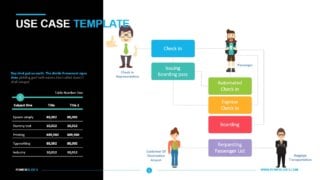
Use Case Template

Product Roadmap Template
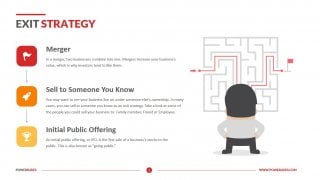
Exit Strategy

Digital Transformation
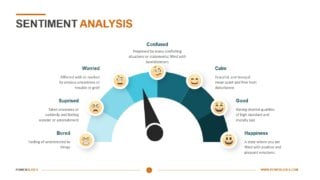
Sentiment Analysis

Acceptance Criteria
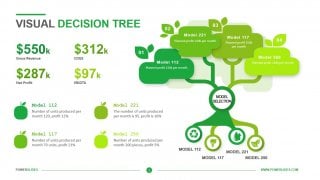
Visual Decision Tree
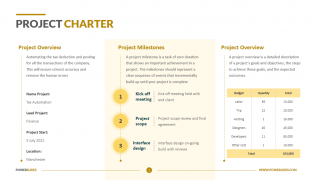
Project Charter
Multiple Device Mockup
You dont have access, please change your membership plan., great you're all signed up..., verify your account.
PowerSlides.com will email you template files that you've chosen to dowload.
Please make sure you've provided a valid email address! Sometimes, our emails can end up in your Promotions/Spam folder.
Simply, verify your account by clicking on the link in your email.

- April 5, 2022
Data Transformation Explained
Shayaan Saiyed
- Data Engineering 101
The ever-growing volume of data empowers companies to enhance decisions and fasten outcomes. Data is an advantage, but only if the business can use it. So how do you structure and make data accessible for stakeholders to drive insights? The answer is data transformation.
Raw data is not valuable until we do the hard work of transforming it to a state where the business can use it. Data teams must first arrange and format data so that they can create dashboards, reports, and predictive models. In this article, we’ll cover the basics of data transformation to set the required foundation for delivering business value.
What Is Data Transformation?
Data transformation is the process of converting data from one format, structure, or set of values to another by way of joining, filtering, appending, or otherwise performing some sort of computation on the data. The data transformation process is managed within a data pipeline . More specifically, the T in the ETL or ELT pipelines stands for transformation.
While data transformation is a relatively simple concept, in practice it can be quite nuanced. If companies have ingested their data, can’t they use that data to create business analytics and dashboards? Why would they need to change it? Simply put, that data is very rarely in the right format and structure to be useful or usable to the right parties.
First off, when data is ingested from an API, blob storage, data warehouse, or another source, you have no control over the format. Most often, the data will not be in the fitting format for your destination. Beyond standardizing the format, there are many steps required to get data to a state where you can work with it. Or even apply it to your use cases and derive its full benefit. For example, filter out bad data, perform data quality checks, and aggregate data downstream .
That’s what data transformation is: the process of making your data valuable, usable, and reusable. The goal is to keep data organized and make it more compatible and easier for humans and computers to use.
Most Common Data Transformation Functions
A data team has infinite computational power over the data. However, each transformation layer’s design needs to satisfy the ultimate business requirement. The most common data transformation functions include:
Extraction and Parsing
In the early phases, you’re reformatting data, extracting certain fields, parsing, and looking for specific values. A data pipeline process starts with ingesting data from a source, followed by copying the data to a destination. This transformation technique concentrates on modifying the format and structure of the data. The objective is to guarantee that the data is compatible with the target system.
Filtering and Mapping
Afterwards, you’re refining your data by filtering or mapping fields and values. For example, you may want to display low-activity users in a customer-facing application. Or, the state field in your source may show New York as “New York,” but the destination may store it as “NY”.
Data Enrichment
This type of transformation involves bringing in data from another source and adding it to your data set. For instance, you may want to add user metadata to build a more detailed view of specific users. In this phase, enriching the data can often turn into its own form of data ingestion . This step highlights just how sophisticated data transformation can get.
Cross-Record Correlation
This type of data transformation involves analytical-style operations, such as “count how many users during a particular time did x, y, or z.” There’s also ‘correlation of events’. You may want to determine if activities are distinct user sessions by correlating one user’s activity with the previous one. Or correlating to the following session and looking at the duration of the time gap. The transformation that happens, in this case, is the ordering and clustering of events.
Let’s dive into an example. Your data is being ingested in a different format than you generally like to work with. Let’s say a log format, with some JSON-structured objects thrown in. In this case, it’s mostly semi-structured text data, as is often the case when data is coming from a back-end system that is logging user activity. Once you start to do analytical-style operations on the data, you need to take it from JSON-compressed files to columnar structures. That involves taking the JSON data, decompressing it, and putting it into a column format.
Another example is filtering out the data you’re not interested in. This filter isn’t simply based on individual users, but also on the larger groups of people using the data. Let’s say you’re looking for people who create, update, and delete operations. But you are less interested in other types of events. Filtering out the data for those groups is a type of transformation that hones and refines the data set to make it more useful—and accurate for the downstream workload.
How to Transform Your Data
Conceptually, think of data transformation as a bidirectional search. Or finding the shortest path between two points in a graph. You need to map your raw data to your business needs. Then, figure out how to efficiently traverse from both sides towards the middle.
Often, business teams toss requirements to the data team with a list of demands. Other times, data engineering teams look at their data and figure out what to do with it—unrelated to business goals. The real value lies in skillfully blending the two and understanding the context in which the data will be used. Why are people looking for this data set? What are they trying to extract from understanding it? What is the next natural follow-on question they might ask?
Understand Both the Business Needs and the Data
Once you understand the goals the business needs to achieve, only then you can take stock of what data you need to work with. Planning transformations has traditionally taken a waterfall-style approach involving meetings, whiteboards, and diagrams. This can lead to a lot of expensive, complex work. Instead, teams need to make iteration cheap, easy, and streamlined.
Pipelines should be built in minutes to incrementally move forward to meet new business use cases . That includes mapping out the fields, prototyping a query, sending it off to the processing cluster, running the transformations, and validating . Data teams need to understand contextually why the data matters, as much as how to transform it and work with it.
Be Aware of the Physical Limitations of Data Pipelines
As you start querying the data, it’s not uncommon to simply start to transform it as you go without a specific plan. However, we recommend starting by breaking the process down into bite-sized transformations. This makes it easier to maintain the data pipeline as user needs and business logic inevitably change. Make sure the pipeline is simple and understandable enough for stakeholders to come in and make changes, if necessary.
In addition, it is important to understand how the infrastructure that supports your data pipelines needs to scale. As you build your transformations, consider how efficient your logic is, so you don’t run into unexpected errors. For instance, “Out of Memory” errors. This becomes important when you go from processing 100k records in your staging pipelines to millions in production.
Avoid Prematurely Optimizing Your Transformation Logic
Frequently, teams have optimized their transformation logic, but it’s not very maintainable. For instance, avoid winding up with 1,000-line SQL queries with complex, nested sub-queries. This may optimize processing, but not maintenance and engineering efforts. Break down queries into small components and understand the input and output for easier debugging and alteration.
Concurrently, take care not to over-optimize. Especially if you are working with a small data set. Once you get larger data sets and a better understanding of them, you can incorporate sophisticated transformations, such as incremental data propagation or compound nested transforms. Only do performance transformations once they become necessary.
Benefits and Challenges of Data Transformation
There are challenges to transforming data:
- Data transformation can become expensive, depending on the software and resources.
- Data transformation processes can eat up resources, whether on-premises or cloud-based.
- Lack of expertise can introduce problems during transformation, so data analysts, engineers or anyone dealing with data transformation needs to have subject-matter expertise, so they can accurately and properly curate data.
- Enterprises sometimes perform unnecessary transformations—and once changes are made, data teams might have to change it back again to make the data usable.
Even so, transforming data also yields several benefits:
- Once data is transformed, it is organized and easier—sometimes only now possible—for both humans and computers to use.
- Properly formatted and validated data improves data quality and ensures that applications run properly without encountering pitfalls such as incompatible formats, duplicates, or incomplete values.
- Data transformation streamlines interoperability among applications, systems, and types of data.
Final Thoughts About Data Transformation and Next Steps
Data transformation can be a tricky and nuanced step, but with the right tools and process, your data pipelines can become much more valuable, faster. You’ll be able to streamline data pipelines, ensure data integrity, and organize and interpret data in a meaningful way for engineers and analysts alike across data teams.
With Ascend for data transformation , you can easily make data transformation fast and efficient. You can design your pipelines with declarative definitions that require 95% less code and result in far less maintenance and specify inputs, outputs, and data logic in multiple languages: SQL, Python, Scala, and Java specs.
Ascend’s full-featured SDK lets you programmatically create and interact with Ascend components, integrate with code repositories such as Github, and build reusable components. All this helps teams avoid work that’s not essential to deriving business value from data.
With queryable pipelines, you can treat any stage of any data pipeline as a queryable table. You can quickly prototype new pipeline stages or run ad-hoc queries against existing pipeline stages, all in a matter of seconds. When underlying data has changed, you’re immediately notified.
Start transforming or schedule a demo today.
Additional Reading and Resources
- Simplifying the On-Premises to Cloud Migration Journey
- The Future of Data Automation with Ascend.io
- ETL Process: What It Is & How It Works
Let's take this to your inbox.
Table of contents.
Keep Reading

Snowflake Summit 2024 Reflections: An Exciting Road Ahead for Data Engineering
Snowflake Summit 2024 has set the stage for exciting changes in the data landscape. As a data enthusiast and a leader in data engineering, I’m eager to share my reflections on these innovations and their implications for Ascend.
Wizeline and Ascend.io Join Forces to Unleash AI-Powered Data Automation
Strategic partnership to deliver significant enhancements in efficiency, security, and modernization with advanced AI technology solutions & services SAN FRANCISCO, CA, May 7, 2024 – Wizeline, a leading AI-powered software

Introducing Project Inception: The Next Evolution in Data Automation
At Ascend, we believe it’s time to rethink data engineering from the ground up. As the world of data continues to evolve at a breakneck pace, we are thrilled to announce the next revolutionary step in our journey – Project Inception.
Subscribe and get all the articles delivered straight to your inbox. Or customize your subscription to receive only the topics you are most interested in.

Ascend.io is the leader in Data Automation, empowering data teams to deliver production-ready data pipelines 10x faster by deploying automation and AI.
Ready to automate your data pipelines?

Data Transformation: Benefits, Types, and Processes

Lukas Racickas

Data transformation involves converting data from one format into another for further processing, analysis, or integration. The data transformation process is an integral component of data management and data integration. Likewise, companies can improve their data-driven decision-making by streamlining their data management and integration processes through data transformation.
However, as more and more companies adopt cloud-based data storage ( IDC reports that today 67% of enterprise infrastructure is cloud-based), the data transformation process must follow suit. Consequently, many companies are searching for public web data integration processes and data transformation tools that help improve the data quality, readability, and organization company-wide.
In this article, I will explore the data transformation process, how it contributes to the broader processes of data integration, as well as new data transformation technologies.
Benefits of data transformation
From a general perspective, data transformation helps businesses take raw data (structured or unstructured) and transform it for further processing, including analysis, integration, and visualization. All teams within a company’s structure benefit from data transformation, as low-quality unmanaged data can negatively impact all facets of business operations. Some additional benefits of data transformation include:
- Improved data organization and management
- Increased computer and end-user accessibility
- Enhanced data quality and reduced errors
- Greater application compatibility and faster data processing
Data integration
Before examining the various ways to transform data, it is important to take a step back and look at the data integration process. Data integration processes multiple types of source data into integrated data, during which the data undergoes cleaning, transformation, analysis, loading, etc. With that, we can see that data transformation is simply a subset of data integration.
Data integration as a whole involves extraction, transformation, cleaning, and loading. Over time, data scientists have combined and rearranged these steps, consequently creating four data integration processes: batch, ETL, ELT, and real-time integration.
Batch integration
Another common method is batch data integration, which involves moving batches of stored data through further transformation and loading processes. This method is mainly used for internal databases, large amounts of data, and data that is not time-sensitive.
ETL integration
Similar to ELT, ETL data processing involves data integration through extraction, transformation, and loading. ETL integration is the most common form of data integration and utilizes batch integration techniques.
ELT integration
ELT data processing involves data integration through extraction, loading, and transformation. Similar to real-time integration, ELT applies open-source tools and cloud technology, making this method best for organizations that need to transform massive amounts of data at a relatively quick pace.
Real-time integration
One of the more recent data integration methods, real-time integration, processes and transforms data upon collection and extraction. This method utilizes CDC (Change Data Capture) techniques, among others, and is helpful for data processing that requires near-instant use.
These same concepts utilized in data integration have also been applied to the individual steps within the larger integration process, such as data transformation. More specifically, both batch data processing and cloud technology, utilized in real-time integration, have been crucial in developing successful data transformation processes and data transformation tools. Now, let’s take a closer look at the types of data transformation processes.
First party data (data you collect yourself about your company and your customers) is rapidly growing in value. Your ability to transform and use that data to drive decisions and strategies will increasingly become the source of competitive advantage. - Rich Edwards, CEO of Mindspan Systems

Types of data transformation
Batch data transformation.
Batch data transformation, also known as bulk data transformation, involves transforming data in groups over a period of time. Traditional batch data transformation involves manual execution with scripted languages such as SQL and Python and is now seen as somewhat outdated.
More specifically, batch transformation involves ETL data integration, in which the data is stored in one location and then transformed and moved in smaller batches over time. It is important to note the significance of batch data transformation on many data integration processes, such as web application integration, data warehousing, and data virtualization. When applied to other data integration processes, the concepts and logistics within batch data transformation can improve the overall integration process.
Interactive data transformation
As many companies turn to cloud-based systems, IBM even reports that 81% of companies use multiple cloud-based systems , end-users of said data are also looking for more versatile methods to transform data. Interactive data transformation, also referred to as real-time data transformation uses similar concepts seen in real-time integration and ELT processing.
Interactive data transformation is an expansion of batch transformation. However, the steps are not necessarily linear. Gaining traction for its accessible end-user visual interface, interactive data transformation takes previously generated and inspected code to identify outliers, patterns, and errors within the data. It then sends this information to a graphical user interface for human end-users to quickly visualize trends, patterns, and more, within the data.
Data transformation languages
In addition to the various types of data transformation, developers can also utilize a variety of transformation languages to transform formal language text into a more useful and readable output text. There are four main types of data transformation languages: macro languages, model transformation languages, low-level languages, and XML transformation languages.
The most commonly used codes in data transformation include ATL, AWK, identity transform, QVT, TXL, XQuery, and XSLT. Ultimately, before deciding what transformation method and language to use, data scientists must consider the source of the data, the type of data being transformed, and the project’s objective.
The data transformation process
Now that we’ve covered the bigger picture of how data transformation fits into the larger picture of data integration, we can examine the more granular steps in data transformation itself. Firstly, it is important to note that while it's possible to transform data manually, today, companies rely on data transformation tools to partially or fully transform their data. Either way, manual and automated data transformation involves the same steps detailed below.
1. Data discovery and parsing
The first step in the data transformation process involves data discovery and data parsing . Data discovery and data parsing are processes that involve collecting data, consolidating data, and reorganizing data for specific market insights and business intelligence. At Coresignal, we can offer you parsed, ready-to-use data.

2. Data mapping and translation
Once you have profiled your data and decided how you want to transform your data, you can perform data mapping and translation. Data mapping and translation refer to the process of mapping, aggregating, and filtering said data so it can be further processed. For example, in batch transformation, this step would help filter and sort the data in batches so executable code can run smoothly.
3. Programming and code creation
The data programming involves code generation, in which developers will work with executable coding languages, such as SQL, Python, R, or other executable instructions. During this stage, developers are working closely with transformation technologies, also known as code generators. Code generators provide developers with a visual design atmosphere and can run on multiple platforms, making them a favorite among developers.
4. Transforming the data
Now that the code is developed, it can be run against your data. Also known as code execution, this step is the last stage the data passes through before reaching human end-users.
5. Reviewing the data
Once the code executes the data, it is now ready for review. Similar to a quality assurance check, the purpose of this step is to make sure the data has been transformed properly. It is important to note that this step is iterative, in that end-users of this data are responsible for reporting any errors they found in transformed data to the developers, so edits to the code can be made.
Data extraction and transformation have an effect on other business activities. When data is transformed into a more readable format, data analysis can be completed more quickly and accurately than before. Not only does this have an effect on employee morale, but it also has an impact on company decision-making. - Brian Stewart, CTO of ProsperoWeb

ETL vs. ELT
The recent advancements in big data have required businesses to look elsewhere when storing, processing, and analyzing their data. Moreso, the increasing variety in data sources has also contributed to the strain being placed on data warehouses. Particularly, while companies acquire powerful raw data from data types such as firmographic data, employee data, and social media data, these same data types typically export very large file sizes. Consequently, companies have been searching for alternative methods.
This search has greatly impacted data integration processes, specifically data transformation. That is, companies have been transitioning from traditional data integration processes, such as ETL methods, to cloud-based integration processes, such as ELT and real-time integration.
In the past, many companies have relied on local servers for data storage, making ETL integration the preferred method. However, due to the significant increase in digital communication and business operations in 2020, global data creation is now modeled at a CAGR of 23% , according to Businesswire. Subsequently, the upward trend in global data creation has put a strain on local servers and data storage, and many businesses are looking elsewhere for cloud-based solutions.
What is data transformation in ETL?
ETL, which stands for extraction, transformation, and loading, is a data integration process that involves extracting data from various external sources, often from third-party data providers , transforming the data into the appropriate structure, and then loading that data into a company’s database. The ETL process is considered the most common integration process compared to ELT, ETM, and EMM transformation processes.
Data transformation within ETL occurs in the transformation step; however, it is closely linked to the extraction and loading stages. Traditionally, data transformation within the ETL method utilizes batch transformation with linear steps, including discovery, mapping, programming, code execution, and data review.
As businesses collect an increasing volume of data, many are forced to find data storage and processing solutions that can handle massive amounts of data with limited money and resources. Similarly, companies are also looking for data transformation solutions that can meet the current needs and industry standards. Companies are recognizing the future of data transformation and shifting towards utilizing cloud-based technology in processes such as ELT integration and interactive data transformation.
This article was originally published on Data Science Central .
Related articles

Data Storage: JSON vs. CSV
Understanding data storage is necessary for professionals working in data-driven businesses. Read more to learn the benefits of harnessing the power of different data storage formats.

Structured vs. Unstructured Data: Key Differences
Structured data is formatted and organized for readability within relational databases. Unstructured data’s format is undefined, not well-organized, and not usable by relational databases.
.webp)
The Critical Role of Data Cleaning
As a product manager, I have closely worked with data engineering teams and witnessed the fantastic ways to transform raw web data into insights, products, data models, and more.
Data Transformation: Understanding the Basics
What is data transformation.
Data transformation is the process of taking data that exists in one format or state and converting it into a different format or state. Transformation is the middle step in the extract, transform, and load (ETL) process — and the final step in the extract, load, transform (ELT) process.
Why Transform Your Data?
Data can serve many purposes. Data is transformed to suit your needs. When you convert raw data from its source — from locations like customer transactions, files or databases — you make that data more usable. Once you’ve transformed data, you can do other things with it. For example, you can use transformed data in analytics to gain trustworthy and actionable business intelligence, verify data quality by enforcing specific date ranges or to simply run business functions. You can even apply mathematical functions within data transformation for machine learning or data science purposes.
Data Transformation helps application systems communicate in a common language
To achieve the greatest value from your data, you need to normalize or standardize it to be fit for your needs. Transformations can be active (it will modify the number of rows) or passive (the number of rows is not changed, data is only modified at the row level), and can include cleansing, consolidation, code lookups and general calculations. Some common types of data transformation include:
The Aggregator transformation performs aggregate calculations, such as averages and sums. The integration service performs aggregate calculations as it reads and stores data group and row data in an aggregate cache. The aggregator transformation is an active transformation.
Data Masking
You use a Data Masking transformation to change sensitive production data to realistic test data for non-production environments. The Data Masking transformation modifies source data based on masking rules that you configure for each column. This type of transformation lets you create masked data for software development, analytics, testing, training and data mining. You can maintain data relationships in the masked data and maintain referential integrity between database tables. The Data Masking transformation is a passive transformation.
Use the Expression transformation to calculate values in a single row. For example, you might need to adjust employee salaries, concatenate first and last names or convert strings to numbers. You can also use the Expression transformation to test conditional statements before you pass the results to a target or other transformations. The Expression transformation is a passive transformation.
Use the Joiner transformation to join source data from two related heterogeneous sources residing in different locations or file systems. You can also join data from the same source. The Joiner transformation joins sources with at least one matching column and uses a condition that matches one or more pairs of columns between the two sources. The Joiner transformation is an active transformation.
Use the Filter transformation to filter out rows in a mapping. As an active transformation, the Filter transformation may change the number of rows passed through it. The Filter transformation allows rows that meet the specified filter condition to pass through. It drops rows that do not meet the condition. You can filter data based on one or more conditions. The Filter transformation is an active transformation.
A filter condition returns TRUE or FALSE for each row that the Integration Service evaluates, depending on whether a row meets the specified condition. For each row that returns TRUE, the Integration Services passes through the transformation. For each row that returns FALSE, the Integration Service drops and writes a message to the session log.

Use a Lookup transformation in a mapping to look up data in a flat file, relational table, view or synonym. You can import a lookup definition from any flat file or relational database. You can also create a lookup definition from a source qualifier. You can use multiple Lookup transformations in a mapping. Although the Lookup transformation can be an active or passive transformation, it is mostly a passive transformation.
You can select only the top or bottom rank of data with a Rank transformation. The Rank transformation is an active transformation. Use a Rank transformation to return the largest or smallest numeric value in a port or group. You can also use a Rank transformation to return the strings at the top or the bottom of a session sort order. During the session, the Integration Service caches input data until it can perform the rank calculations.
The Rank transformation differs from the transformation functions MAX and MIN, in that it lets you select a group of top or bottom values, not just one value. For example, use Rank to select the top 10 salespeople in a given territory. Or, to generate a financial report, you might also use a Rank transformation to identify the three departments with the lowest expenses in salaries and overhead. While the SQL language provides many functions designed to handle groups of data, identifying top or bottom strata within a set of rows is not possible using standard SQL functions.
You connect all ports representing the same row set to the transformation. Only the rows that fall within your configured rank measures pass through the Rank transformation. You can also write expressions to transform data or perform calculations.

As an active transformation, the Rank transformation might change the number of rows passed through it. You might pass 100 rows of data to the Rank transformation but choose to rank only the top 10 rows and pass them from the Rank transformation to another transformation.
A Router transformation is similar to a Filter transformation because both transformations allow you to use a condition to test data. A Filter transformation tests data for one condition and drops the rows of data that do not meet the condition. However, a Router transformation tests data for one or more conditions and gives you the option to route rows of data that do not meet any of the conditions to a default output group. The Router transformation is an active transformation.
The Union transformation is a multiple input group transformation that you use to merge data from multiple pipelines or pipeline branches into one pipeline branch. It merges data from multiple sources like the UNION ALL SQL statement to combine the results from two or more SQL statements. Similar to the UNION ALL statement, the Union transformation does not remove duplicate rows. The Union transformation is an active transformation.
You can add an XML Source Qualifier transformation to a mapping by dragging an XML source definition to the Cloud Mapping Designer workspace or by manually creating one. When you add an XML source definition to a mapping, you need to connect it to an XML Source Qualifier transformation. The XML Source Qualifier transformation defines the data elements that the integration service reads when it executes a session. The XML Source Qualifier transformation is an active transformation. You can also apply XML parser and XML generator transformations.
The Normalizer transformation receives a row that contains multiple-occurring columns and returns a row for each instance of the multiple-occurring data. The transformation processes multiple-occurring columns or multiple-occurring groups of columns in each source row. The Normalizer transformation is an active transformation.
H2R and R2H Transformation
To convert hierarchical data models to relational database you can use H2R transformations and change relational data to hierarchical data apply R2H transformation. H2R transformation is predominantly used to convert the XML JSON hierarchical input to relational outputs.
Where Do You Transform Your Data?
The answer depends on your priorities and resources. A dedicated cloud data integration environment offers versatility, scalability and high availability. But if your data is already in the database, your cloud data warehouse may be the better option because then you can limit data movement.
ELT allows you to do the transformations using the compute resources of the cloud data warehouse – without having to move the data out of it.
Transforming data after uploading it to modern cloud ecosystems is most effective for:
- Large enterprises with vast data volumes
- Companies that require real-time or frequent access to data
- Data scientists who rely on a single data warehouse, lake or lakehouse for business intelligence
- IT departments and data stewards interested in a low-maintenance solution
The ELT process improves data conversion and manipulation capabilities due to parallel load and data transformation functionality. This schema allows data to be accessed and queried in near real time.
However, you might want to stick with ETL if your business collects data from multiple source systems, or the data is in dissimilar formats or you have dirty data: duplicate, incomplete or inaccurate data will require data engineers to clean and format prior to data loading.
How Data Transformation Drives Digital Transformation
Most people understand that better data will result in better business outcomes. The reverse is also true. A recent survey by Experian found that 95% of organizations believed poor data quality hurts their business.
Digital transformation has put data at the center of every organization.
There’s been an explosion in data over the past few decades. Costs for storage and processing have gone down dramatically. On top of that, the regulatory focus on data quality, policy and governance is higher than ever. For these reasons and more, enterprises have reshaped their business models to harness the great potential of a core business asset: their data.
Successful data transformation lets businesses extract all kinds of data, from everywhere. They can take data — from the cloud, mobile, streaming, IoT, social data, or others — and use it for the good of their business. Feed high-quality, transformed data into different applications to drive better decision making. Streamline operations with machine-to-machine communication free of bugs due to dirty data. In fact, the total reimagining of business in the digital age revolves around data transformation. And what is that but digital transformation?
By transforming your data, you can improve business processes across the entire enterprise. This allows you to:
- Deliver better customer experiences
- Make decisions that are better, faster and more accurate
- Streamline operational processes to drive cost savings
- Seize new revenue opportunities
5 Key Benefits of Data Transformation
The scale, automation and trust required by today’s modern enterprise can only be achieved with AI/ML capabilities. AI/ML requires that you normalize or transform your data for one source of truth. Five key reasons organizations transform their data:
- Ensure the data that enters your enterprise is usable and manageable
- Facilitate cost-efficient storage — no need to pay to store multiple versions of the same information
- Improve ease of analysis for greater business intelligence and operational efficiency
- Prioritize resources, especially critical in ERP and finance use cases
- Limit compliance risk, ensuring data is managed according to your data governance rules
Data Transformation Success Stories
Many organizations have achieved dramatic business success with their data transformation efforts. Here are a few examples:
- Avis Budget Group optimized real-time data from a connected fleet of 650,000 vehicles. Using this vehicle data, they were able to enhance efficiency, reduce costs and drive more revenue.
- Equinix , a cloud-based IT services provider, had data duplicated and siloed throughout many data warehouses. After they cleaned and transformed that data, Equinix was able to expedite the rollout of new solutions for their customers. They were also able to prepare their data to deploy new AI and machine learning initiatives.
- Lagardère Travel Retail replaced a manual, hand-coded process with a new automated data transformation platform. As a result, this global leader in the travel retail industry can now quickly share data from many diverse systems.
Learn More About Data Transformation
Businesses, markets and technologies evolve and change over time. Your one constant for a sustainable competitive advantage is data. That's why we help you transform it from simply binary information to extraordinary innovation.
Whether you’re driving next-gen analytics, delivering perfectly timed customer experiences or ensuring governance and privacy, you can always know your data is accurate, your insights are actionable and your possibilities are limitless.
Want more information on data transformation and how Informatica can help? Start with these resources:
- eBook: Modernizing Data Management with Next-Gen iPaaS
- Data 4.0: The Soul of Digital Transformation
- Blog: Real-Time Data Drives Strategic Decisions
- Enterprise Management Associates Report: AI/ML-Powered Data Management Enables Digital Transformation
- Free Data Integration

- United States
- Netherlands
- New Zealand
- Southeast Asia
- Switzerland (French)
- Switzerland (German)
- United Kingdom
- United Arab Emirates
Cloud Platform
Get Started
Learn Data Integration

© Informatica Inc.
- Data Science
- Data Analysis
- Data Visualization
- Machine Learning
- Deep Learning
- Computer Vision
- Artificial Intelligence
- AI ML DS Interview Series
- AI ML DS Projects series
- Data Engineering
- Web Scrapping
What is Data Transformation?
Data transformation is a critical step in data analysis process, encompassing the conversion, cleaning, and organizing of data into accessible formats. This process is critical for businesses looking to utilize their data to generate timely business insights, as it ensures that the information is accessible, consistent, secure, and finally recognized by the intended business users.
In this article, we’ll understand the introductory knowledge of data transformation, its many operations, methodologies, and tools, as well as its benefits, drawbacks, and best practices.
Table of Content
Understanding Data Transformation
Importance of data transformation, key data transformation operations for effective analysis, data transformation techniques and tools, advantages and limitations of data transformation, best practices for data transformation, applications of data transformation.
The process of data transformation, involves converting, cleansing, and structuring data into a usable format which is used to analyzed to support decision-making processes. It includes modifying the format, organization, or values of data to prepare it for consumption by an application or for analysis. This crucial process is undertaken by organizations seeking to leverage their data to provide timely business insights, ensuring that the information is accessible, consistent, safe, and eventually acknowledged by the targeted business users.
The transformations can be divided into two categories: Simple transformations and Complex Data Transformations.
- Simple Data Transformations include straightforward procedures including data cleansing, standardization, aggregation, and filtering. These transformations are often carried out utilizing simple data manipulation methods and are frequently used to prepare data for analysis or reporting.
- Complex Data Transformations include more advanced processes such data integration, migration, replication, and enrichment. These transformations often need complex data manipulation methods like as data modeling, mapping, and validation, and are commonly used to prepare data for advanced analytics, machine learning, or data warehousing applications.
Data transformation is important because it improves data quality, compatibility, and utility. The procedure is critical for companies and organizations that depend on data to make informed decisions because it assures the data’s accuracy, reliability, and accessibility across many systems and applications.
- Improved Data Quality: Data transformation eliminates mistakes, inserts in missing information, and standardizes formats, resulting in higher-quality, more dependable, and accurate data.
- Enhanced Compatibility : By converting data into a suitable format, companies may avoid possible compatibility difficulties when integrating data from many sources or systems.
- Simplified Data Management: Data transformation is the process of evaluating and modifying data to maximize storage and discoverability, making it simpler to manage and maintain.
- Broader Application: Transformed data is more useable and applicable in a larger variety of scenarios, allowing enterprises to get the most out of their data.
- Faster Queries: By standardizing data and appropriately storing it in a warehouse, query performance and BI tools may be enhanced, resulting in less friction during analysis.
Various methods of data transformation exist, depending on the complexity and nature of the process:
- Normalization : Modifying data scales, such as scaling values from 0 to 1, to enable comparisons.
- Standardization : Transforming data to have a unit variance and zero mean, which is frequently required before using machine learning methods.
- Encoding: Transforming categorical data into numerical representations using label or one-hot encoding, for example.
- Discretization: Converting continuous data into discrete bins, which in some circumstances can facilitate analysis and enhance model performance.
- Attribute Generation: Creating new variables from existing data, such as deriving an ‘age’ variable from a date of birth.
- Revising : Ensuring that the data supports its intended usage by deleting duplicates, standardizing the data collection, and purifying it.
- Manipulation: Creating new values from existing ones or changing the state of data through computing.
- Separating: Splitting down data values into component for filtering on certain values.
- Combining/Integrating: Bringing together data from several tables and sources to provide a comprehensive picture of an organization.
- Binning or Discretization: Continuous data can be grouped into discrete categories, which is helpful for managing noisy data.
- Smoothing: Methods like moving averages can be applied to reduce noise in time series or create smoothed data.
- Logarithmic or Exponential Transformation : Data distribution can be altered through logarithmic or exponential functions for specialized analyses.
- Text Preprocessing : Text data can be prepared for NLP (Natural language processing) tasks by tokenizing, stemming , or lemmatizing.
There are several ways to alter data, including:
- Programmatic Transformation: automating the transformation operations via the use of scripts or computer languages such as Python, R, or SQL.
- ETL Tools: Tools for extracting, transforming, and loading data (ETL) are made to address complicated data transformation requirements in large-scale settings. After transforming the data to meet operational requirements, they extract it from several sources and load it into a destination like a database or data warehouse.
- Normalization/Standardization: Scikit-learn in Python provides functions for normalization and standardization such as MinMaxScaler and StandardScaler.
- Encoding Categorical variables: Pandas librayr in python provides get_dummies function employed for one-hot encoding . For label encoding LabelEncoder is provided by Scikit-learn.
- Imputation: Missing values in the dataset are filled using statistical methods like fillna method in Pandas Library. Additionally, missing data can be imputed using mean, median, or mode using scikit-learn’s SimpleImputer .
- Feature Engineering: To improve model performance, new features are developed by combining old ones. Pandas, a Python library, is often used to execute feature engineering tasks. Functions such as apply, map, and transform are used to generate new features.
- Aggregation and grouping: Pandas groupby function is used to group data and execute aggregation operations such as sum, mean, and count.
- Text preprocessing: Textual data is preprocessed by tokenizing, stemming, and eliminating stop words using NLTK and SpaCy Python libraries.
- Dimensional Reduction: The technique involves reducing the amount of characteristics while retaining vital information. Scikit-learn in Python provides techniques such as PCA for Principal Component Analysis and TruncatedSVD for Dimensionality Reduction.
Advantages of Data Transformation
- Enhanced Data Quality: Data transformation aids in the organisation and cleaning of data, improving its quality.
- Compatibility: It guarantees data consistency between many platforms and systems, which is necessary for integrated business environments.
- Improved Analysis: Analytical results that are more accurate and perceptive are frequently the outcome of transformed data.
Limitations of Data Transformation
- Complexity: When working with big or varied datasets, the procedure might be laborious and complicated.
- Cost: The resources and tools needed for efficient data transformation might be expensive.
- Risk of Data Loss: Inadequate transformations may cause important data to be lost or distorted.
A few pragmatic aspects need to be kept in mind when transforming data:
- Knowing the Data: It’s critical to have a thorough grasp of the data, including its type, source, and intended purpose.
- Selecting the Appropriate Tools: The right tools, from basic Python scripting to more complicated ETL tools, should be chosen based on the quantity and complexity of the dataset.
- Observation and Verification: To guarantee that the data transformation processes produce the desired outputs without causing data loss or corruption, ongoing validation and monitoring are essential.
Applications for data transformation are found in a number of industries:
- Business intelligence (BI) is the process of transforming data for use in real-time reporting and decision-making using BI technologies.
- Healthcare: Ensuring interoperability across various healthcare systems by standardization of medical records.
- Financial Services: Compiling and de-identifying financial information for reporting and compliance needs.
- Retail: Improving customer experience through data transformation into an analytics-ready format and customer behavior analysis.
- Customer Relationship Management (CRM): By converting customer data, firms may obtain insights into consumer behavior, tailor marketing strategies, and increase customer satisfaction.
Data transformation is an important phase allowing firms to get useful insights from their data. Data transformation improves data quality, interoperability, and usefulness, allowing for more informed decision-making and supporting a broad variety of applications across sectors. While there are significant problems and restrictions, the advantages of data translation far exceed the expenses. Organizations may achieve a competitive advantage in their specific industries by comprehending the data, choosing the relevant tools, and monitoring and confirming the transformation process.
For more, refer to:
- Data Transformation in Data Mining
- Data Transformation in Machine Learning

Please Login to comment...
Similar reads, improve your coding skills with practice.
What kind of Experience do you want to share?

Data Transformation
Sep 15, 2014
1.19k likes | 3.55k Views
Data Transformation. Objectives: Understand why we often need to transform our data The three commonly used data transformation techniques Additive effects and multiplicative effects Application of data transformation in ANOVA and regression. Why Data Transformation?.
Share Presentation
- data transformation
- data differ
- transformed data
- data transformation techniques
- calculation suggest log transformation

Presentation Transcript
Data Transformation • Objectives: • Understand why we often need to transform our data • The three commonly used data transformation techniques • Additive effects and multiplicative effects • Application of data transformation in ANOVA and regression.
Why Data Transformation? • The assumptions of most parametric methods: • Homoscedasticity • Normality • Additivity • Linearity • Data transformation is used to make your data conform to the assumptions of the statistical methods • Illustrative examples
Homoscedasticity and Normality The data deviates from both homoscedasticity and normality.
Homoscedasticity and Normality Won’t it be nice if we would make data look this way?
Types of Data Transformation • The logarithmic transformation • The square-root transformation • The arcsine transformation. • Data transformation can be done conveniently in EXCEL. • Alternatives: Ranks and nonparametric methods.
Homoscedasticity • The two groups of data seem to differ greatly in means, but a t-test shows that the means do not differ significantly from each other - a surprising result. • The two groups of data differ greatly in variance, and both deviate significantly from normality. These results invalidate the t-test. • We calculate two ratios: var/mean ratio and Std/mean ratio (i.e., coefficient of variation). • Group1 Group2Var/mean 56.420 416.891C.V. 1.230 1.230 • Log-transformation
Log-Transformed Data NewX = ln(X+1) • The transformation is successful because: • The variance is now similar • Deviation from normality is now nonsignificant • The t-test revealed a highly significant difference in means between the two groups 1.31 2.13
Log-Transformed Data Transform back: NewX = ln(X+1) Compare this mean with the original mean. Which one is more preferable? Calculate the standard error, the degree of freedom, and 95% CL (t0.025,16 = 2.47).
Normal but Heteroscedastic Any transformation that you use is likely to change normality. Fortunately, t-test and ANOVA are quite robust for this kind of data. Of course, you can also use nonparametric tests.
Normal but Heteroscedastic The two variances are significantly different. The t-test, however, detects significant difference in means. You can use nonparametric methods to analyse data for comparison, and you are like to find t-test to be more powerful.
Additivity • What experimental design is this? • Compare the group means. Is there an interaction effect? Additivity means that the difference between levels of one factor is consistent for different levels of another factor.
Multiplicative Effects • Compare the group means. Is there an interaction effect? • Does this data set meet the assumption of additivity? • When the assumption of additivity is not met, we have difficulty in interpreting main effects. • Now calculate the ratio of group means. What did you find?
Multiplicative Effects For Factor A, we see that Level 2 has a mean about 2.88 times as large as that for Level 1. For factor B, Level 2 has a mean about 2.18 times as large as that for Level 1). If you know the value for Level 1 of Factor A, you can obtain the value for Level 2 of Factor A by multiplying the known value by 2.88. Similarly, you can do the same for Factor B. We say that the effect of Factors A and B are multiplicative, not additive.
Log-transformation Original Data 37.262 108.458 2102.351 17878.648 82.403 234.508 12400.091 80241.944 3.084 4.127 1.302 1.268 3.778 4.803 1.235 1.385 Transformed data Mean Variance Now log-transform the data. Compare the means. Is the assumption of additivity met now? 1.31 2.13
Why log-transformation can change the multiplicative effects to additive effects?
Square-Root Transformation • The two groups of data differ much in variance. • Calculate two ratios: var/mean ratio and Std/mean ratio (i.e., coefficient of variation). • Does your calculation suggest log-transformation? When is log-transformation appropriate? • Use square-root transformation when different groups have similar Variance/Mean ratios Notice the means, which do not coincide with the most frequent observations
Square-Root Transformation Square-root transformation: Transform the means back to the original scale and compare these means with the original means: 1.17 2.09 The variance is now almost identical between the two groups
Quiz on Data Transformation The data set is right-skewed for each group. Calculate the variance/mean ratio and C.V. for each group, and decide what transformation you should use. Do the transformation and convert the means back to the original scale.
With Multiple Groups When you have multiple groups, a “Variance vs Mean” or a “Std vs Mean” plot can help you to decide which data transformation to use. The graph on the left shows that the Var/Mean ratio is almost constant. What transformation should you use?
Confidence Limits Before transformation After transformation With the skewness in our data, do confidence limits on the right make more sense? Why?
Arcsine Transformation • Used for proportions • Compare the variances before and after transformation • Do you know how to transform the means and C.L. back to the original scale?
Data Transformation Using SAS Data Mydata; input x; newx=log(x); newx=sqrt(x+3/8); newx=arsin(sqrt(x)); cards; Natural logarithm transfromation Square-root transformation Arcsine transformation
- More by User

Linked Data as Transformation
Linked Data as Transformation. Philip E. Schreur Stanford University Coalition for Networked Information April 3, 2012. Linked Data Tenets . Use URI’s to name things on the Web Use HTTP URIs so that someone con look them up Have the information provided be useful
230 views • 8 slides
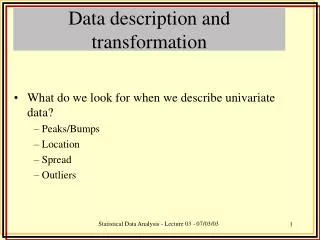
Data description and transformation
Data description and transformation. What do we look for when we describe univariate data? Peaks/Bumps Location Spread Outliers. Window glass. Patterned Glass. Toughened glass. Borosilicates. Lead glass. Data description. Peaks/Bumps Unimodal Bimodal Multimodal
215 views • 18 slides
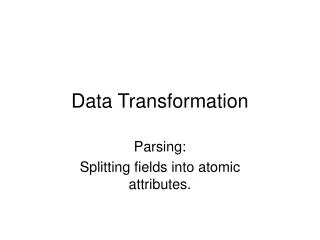
Data Transformation. Parsing: Splitting fields into atomic attributes. =SUBSTR ( string, position<, length> ). Use this when you have a known position for characters. String: character expression Position: start position (starts with 1)
329 views • 6 slides
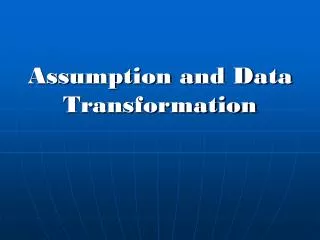
Assumption and Data Transformation
Assumption and Data Transformation. Assumption of Anova. The error terms are randomly, independently, and normally distributed The variance of different samples are homogeneous Variances and means of different samples are not correlated The main effects are additive.
370 views • 13 slides
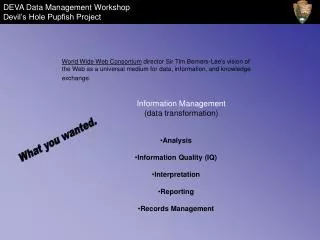
Information Management (data transformation)
DEVA Data Management Workshop Devil’s Hole Pupfish Project. Information Management (data transformation). World Wide Web Consortium director Sir Tim Berners-Lee's vision of the Web as a universal medium for data, information, and knowledge exchange. Analysis Information Quality (IQ)
290 views • 12 slides
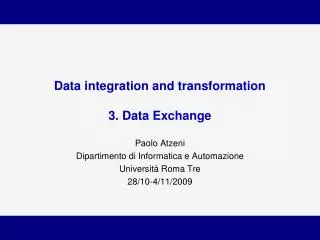
Data integration and transformation 3. Data Exchange
Data integration and transformation 3. Data Exchange. Paolo Atzeni Dipartimento di Informatica e Automazione Università Roma Tre 28/10-4/11/2009. References.
603 views • 47 slides

Econometrics data transformation
Econometrics I Summer 2011/2012 Course Guarantor : prof. Ing. Zlata Sojková, CSc ., Lecturer : Ing. Martina Hanová, PhD. . Econometrics data transformation. Linearity: The true relationship between the mean of the response variable E(Y) and the
261 views • 6 slides
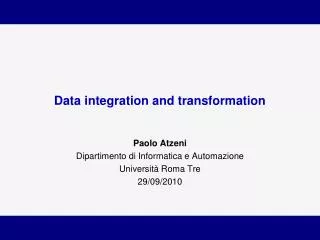
Data integration and transformation
Data integration and transformation. Paolo Atzeni Dipartimento di Informatica e Automazione Università Roma Tre 29/09/2010. A ten-year goal for database research. The “ Asilomar report” (Bernstein et al. Sigmod Record 1999 www.acm.org/ sigmod ):
568 views • 43 slides
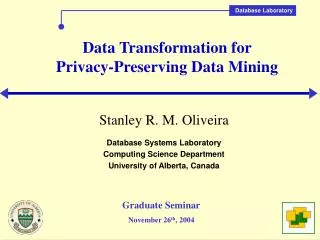
Data Transformation for Privacy-Preserving Data Mining
Database Laboratory. Data Transformation for Privacy-Preserving Data Mining. Stanley R. M. Oliveira Database Systems Laboratory Computing Science Department University of Alberta, Canada. Graduate Seminar November 26 th , 2004. Introduction. Motivation.
802 views • 49 slides

Database Laboratory. Data Transformation for Privacy-Preserving Data Mining. Stanley R. M. Oliveira Database Systems Laboratory Computing Science Department University of Alberta, Canada. PhD Thesis - Final Examination November 29 th , 2004. Introduction. Motivation.
447 views • 24 slides

Data Engineering Data preprocessing and transformation
Data Engineering Data preprocessing and transformation. Just apply a learner? No!. Algorithms are biased No free lunch theorem: considering all possible data distributions, no algorithm is better than another Algorithms make assumptions about data
514 views • 34 slides
Data Cleaning and Transformation
Data Cleaning and Transformation. Helena Galhardas DEI IST (based on the slides: “A Survey of Data Quality Issues in Cooperative Information Systems”, Carlo Batini, Tiziana Catarci, Monica Scannapieco, 23rd International Conference on Conceptual Modelling (ER 2004) ). Agenda. Introduction
708 views • 45 slides

Data Cleaning and Transformation. Playing in the Mud. The Many Roles of Knowledge Workers. Brilliant IS idea. The Gist of the Problem. Getting data out of some system to: Analyze it (e.g. Excel, Access, stats package) Get it into another system (e.g. ERP)
244 views • 11 slides

Data Transformation For Normality
Data Transformation For Normality. An assumption of our analysis is that the data is normally distributed If the data is not normally distributed, then you must do a transformation to get normal data: Log(Y), 1/Y, SQRT(Y).
516 views • 19 slides

Data integration and transformation 3. Data Exchange. Paolo Atzeni Dipartimento di Informatica e Automazione Università Roma Tre 28/10/2009. References.
464 views • 29 slides

Microarray data normalization and data transformation
Microarray data normalization and data transformation. Ka-Lok Ng Asia University. Estimating background. http://www.mathworks.com/company/pressroom/image_library/biotech.html.
569 views • 26 slides

Data Transformation. Data cleaning. Importing Data. Reading data from external formats Libname/Infile/Input for text form data Proc Import for Excel/Access data ODBC for external database data. Importing an Excel Spreadsheet. PROC IMPORT OUT= WORK.Fall2007
430 views • 31 slides

Data Center Transformation Market
The Global Data Center Transformation Market, published by KBV research, The Global Data Center Transformation Market size is expected to reach $13.4 billion by 2024, rising at a market growth of 13.5% CAGR during the forecast period. Full report: https://kbvresearch.com/data-center-transformation-market/
135 views • 9 slides

Data Transformation. Data conversion Changing the original form of the data to a new format More appropriate data analysis New variables. Data Transformation. Summative Score = VAR1 + VAR2 + VAR 3. Descriptive Analysis.
709 views • 50 slides

DATA TRANSFORMATION and NORMALIZATION
DATA TRANSFORMATION and NORMALIZATION. Lecture Topic 4. DATA PRE-PROCESSING. TRANSFORMATION NORMALIZATION SCALING. DATA TRANSFORMATION. Difference between raw fluorescence is a meaningless number Data is transformed: Ratio allows immediate visualization of number Log. Why Log 2?.
522 views • 32 slides

560 views • 49 slides
Newly Launched - AI Presentation Maker

Powerpoint Templates
Icon Bundle
Kpi Dashboard
Professional
Business Plans
Swot Analysis
Gantt Chart
Business Proposal
Marketing Plan
Project Management
Business Case
Business Model
Cyber Security
Business PPT
Digital Marketing
Digital Transformation
Human Resources
Product Management
Artificial Intelligence
Company Profile
Acknowledgement PPT
PPT Presentation
Reports Brochures
One Page Pitch
Interview PPT
All Categories

Data transformation powerpoint presentation slides
Explore our Data Transformation PowerPoint Presentation Slides to display the steps of information migration. Demonstrate data migration approach using this data transfer PPT visuals. The content ready information transfer complete presentation has a set of slides such as data migration approach, data migration steps, data migration lifecycle, data migration process, etc. Showcase migration approach, data analysis, migration design, migration execution, and migration testing with readymade data migration plan Presentation design. Furthermore, system migration PPT visual can also be used for related topics like data conversion, data curation, data preservation, data transformation to name a few. These PPT visuals are designed by our expert designers. Besides this, all the slides given in this PowerPoint presentation are fully editable. The PowerPoint templates can be customized as per requirements of business, education or any other theme. Impress your audience with high quality visually appealing data transfer PowerPoint templates.
- Add a user to your subscription for free
You must be logged in to download this presentation.
PowerPoint presentation slides
Presenting this set of slides with name - Data Transformation Powerpoint Presentation Slides. We bring to you to the point topic specific slides with apt research and understanding. Putting forth our PPT deck comprises of twenty eight slides. Our tailor made Data Transformation Powerpoint Presentation Slides editable presentation deck assists planners to segment and expound the topic with brevity. The advantageous slides on Data Transformation Powerpoint Presentation Slides is braced with multiple charts and graphs, overviews, analysis templates agenda slides etc. to help boost important aspects of your presentation. Highlight all sorts of related usable templates for important considerations. Our deck finds applicability amongst all kinds of professionals, managers, individuals, temporary permanent teams involved in any company organization from any field.

People who downloaded this PowerPoint presentation also viewed the following :
- Business Slides , Flat Designs , Technology and Communication , Complete Decks , All Decks , Data Management , IT
- Data Transformation ,
- Data transfer ,
- Information Migration
Content of this Powerpoint Presentation
Slide 1 : This slide introduces Data Transformation. State Your Company Name and begin. Slide 2 : This is an Agenda slide. State your agendas here. Slide 3 : This slide shows Data Migration Approach describing- Analysis & Discovery, Cleanse, Load, Extract & Profile, Validate and Reconcile. Slide 4 : This slide presents Data Migration Steps which includes- Analysis Stage, Development Stage and Go Live Support Stage. Slide 5 : This slide displays Simplified Illustration of Data Migration Steps which includes- Merge, Process, Update and Deploy. Slide 6 : This slide represents Data Migration PowerPoint Template describing- Migration Approach, Data Analysis, Migration Design, Migration Execution, Migration Testing and Convert into Production. Slide 7 : This slide showcases Data Migration Life Cycle describing- Source of Document, Design Targets, Flow of Design, Execute Migration and Performance Test. Slide 8 : This slide shows Data Migration Four Step Process as- Extract, Transform, Load and Validate. Slide 9 : This slide presents Data Migration Process as- Assess, Plan, Extract, Cleanse, Load and Verify. Slide 10 : This slide displays Data Migration on Cloud as- Create a Request, Prepare & Ship, Receive & Connect, Ingest & Return, Offload & Access, Erase Device. Slide 11 : This slide represents Data Migration Step by Step Process as- Initial Data Extract from Legacy System, Data Mapping & Normalization, Conduct Test Migration, Validate & Adjust, Go - Live, Final Data validation, Load to Destination and Final Data Extract from Legacy System. Slide 12 : This slide showcases Data Migration Flowchart Template describing- Migration Plan, Gather Requirements, Data Identification, Cleansing Data, Transaction Data “Dynamic Data”, Master Data “Static Data”, Data Configuration, Coding Structure and Sub – Master Data. Slide 13 : This slide reminds about 15 minutes tea break. Slide 14 : This slide displays Data Migration Icons. Slide 15 : This slide is titled as Additional Slides for moving forward. Slide 16 : This is Meet Our Team slide with names and designation. Slide 17 : This is About Us slide to show company specifications etc. Slide 18 : This is a Financial slide. Show your finance related stuff here. Slide 19 : This is a Puzzle slide with text boxes. Slide 20 : This is a Timeline slide. Show information related with time period here. Slide 21 : This is a Bulb or Idea slide to state a new idea or highlight information, specifications etc. Slide 22 : This slide shows Post it Notes. Post your important notes here. Slide 23 : This slide displays Pie Chart with data in percentage. Slide 24 : This slide presents Stacked Bar with three products comparison. Slide 25 : This slide represents Area Chart with three products comparison. Slide 26 : This slide showcases Column Chart with additional text boxes to show information. Slide 27 : This slide shows Clustered Bar Chart. You can add or edit data as per requirements. Slide 28 : This is a Thank you slide with address, contact numbers and email address.
Data transformation powerpoint presentation slides with all 28 slides:
Our Data Transformation Powerpoint Presentation Slides have drained the cloud. They have acquired the best collection.

Ratings and Reviews

Like our new look? Read on .
- Start for free
What is data transformation?

A copywriter at Funnel, Sean has more than 15 years of experience working in branding and advertising (both agency and client side). He's also a professional voice actor.
The question of “what is data transformation” can have a wide array of answers that range from surface level overviews to heavy, deep explorations that require a cohesive understanding of programming languages and best practices.
But what about a nice happy medium in between those two polar extremes? Many digital marketers don’t want to be bogged down in the minutiae of data warehousing architectures, but they do want to understand this increasingly important concept.
So let’s explore the world of data transformation together. We’ll dive past the surface explanations. But don’t worry — you won’t need a metaphorical submarine, maybe just your favorite imaginary SCUBA gear.
Here we go!
Data transformation is the process of modifying data to fit a particular purpose or context. This can involve tasks such as cleaning , standardization, or aggregation, all aimed at enhancing data quality and usability for more accurate analysis.
Transformed data, then, is the result of this process. It's data that's been reshaped from its original form into a more structured and usable format. By transforming raw data into a more analyzable form, it paves the way for data-driven decision making in fields like business intelligence.
Let’s explore that a bit further.
A first data transformation example
Think of your ad performance data from social media platform “InstaTok.” Perhaps you’d like to visualize the key performance metrics from the last 6 months. When quickly viewing the raw data, though, you notice that there are some broken cells due to missing values or incorrect data.
If you were to send these raw data values on to your visualization software, your final dashboard would likely be broken in one or more places. In order to avoid this, you need to transform data in order to remove those broken values from the raw data, or to ensure that the data is accurately sent through.
Simple enough, right?
We’re still at surface level in our data transformation exploration, though. To continue our ocean metaphor, here, we are enjoying a nice relaxing snorkel around a reef. Time to plunge a bit deeper.

Why data transformation is so valuable
So, why all the fuss about this data transformation idea? Well, for starters, it’s a critical step in broader, more detailed data analysis and maintenance. However, it’s also common sense for modern digital marketers who are running comprehensive campaigns across many different platforms.
To effectively carry out the data transformation process, a robust data transformation tool is often required. These tools can automate many of the tasks involved in improving data quality like cleaning and standardizing data, making the process more efficient and less prone to error.
Even Facebook and Google, two of the most popular digital advertising platforms, treat data differently. Whether it’s cross-device conversions, clicks, UTM parameters, attribution, and more, it can be extremely difficult to directly compare performance results between the two platforms using their standard raw data sets.
Instead, marketers need to integrate and transform this unstructured data so that the various parameters and metrics align. This is a process also known as data integration or data mapping . Data integration allows you to make easy comparisons between platforms as well as using the combined data to gain higher-level insights from the broader campaign ecosystem.
Beyond ensuring that all of your advertising sources are “speaking the same data language,” it is often worth thinking about the types of data transformations that are useful on a global scale, literally.
Data transformation makes global campaigns easier to analyze
If your campaign is running across international boundaries, or serves customers in different countries, you will almost certainly need to employ some currency transformations.
It’s important to be strategic and careful here, though. This is one of those points where you could stay nice and comfy by our metaphorical reef, or you could drift off into the big dark ocean depths. What we mean is that, with currency, you need to factor in current versus historical conversion rates.
Are you looking at real values? Are your historical values adjusted for inflation? The questions go on, but let’s swim back toward the safety of our reef for a second to talk about a simpler global transformation: time zones.
Imagine you drop a new sneaker or software product to your markets globally. You may want to launch the products at the same moment, regardless of the time zone in each market. That could be noon in the UK, which would be 7 a.m. in New York. When looking back on your performance numbers, it may be valuable to adjust time zone data to reflect the coordinated global launch.
Sending transformed data to your target destination
Let’s also not forget one of the most common reasons we see data transformation being implemented. As we covered previously , Looker Studio is one of the most popular visualization services on the market. It’s robust, solid, and free.
One of its main limitations, however, is that it can only pull data from a single source. Because of this, we see many of our clients start out their data journey (before joining forces with Funnel) by pulling everything into a massive Google Sheet where they apply a series of data transformations. After all, Looker Studio is great at making visualizations, but it's simply not built for transforming and cleaning your data.
For larger organizations, a cloud data warehouse can be a more scalable solution for storing and transforming data. These platforms offer the advantage of high capacity storage, computing power, and distributed processing capabilities. The data warehouse makes it possible to transform data on large datasets in real-time, ensuring that your transformed data is always up-to-date and ready for analysis.
Go deeper: what is a data warehouse?
Is data transformation difficult?
There is a reason we picked a deep sea diving metaphor to speak about data transformation. If you are experienced (or have an expert guide) and you are ready to dive deep, there is plenty of room to explore the topic of data transformation.

For beginners, it’s best to start with simple transformations, and build from there. Feel free to dip your toe in the shallow end, then begin a short “snorkeling adventure.” As your skills and knowledge improve, you can feel confident in exploring transformation further and deeper while creating a refined data transformation process.
However, one of the biggest challenges with data transformation is that, at the more complex level, it often requires custom code and even BI teams. Especially when converting and integrating custom data fields, specialized programming languages and logic need to be employed to ensure that every inconsistency is picked up and addressed.
A common way to achieve this is through regular expressions, or Regex. Think of it as a sort of “find and replace” for your mismatched data. In fact, Alex addressed the topic in one of his Funnel Tips episodes .
The data transformation process
Let's have a quick look at the impact transformation can have on raw data.

What changes when we transform data?
Aesthetic Transformation
This focuses on improving the presentation and consistency of the data without changing its actual meaning. Examples include:
- Standardizing abbreviations (e.g., converting "St." to "Street")
- Converting dates to a consistent format (e.g., YYYY-MM-DD)
- Ensuring units are consistent (e.g., converting all measurements to meters)
Constructive Transformation
This adds information in the data to improve its completeness and usefulness for analysis. This can involve:
- Adding calculated fields (e.g., calculating total sales from quantity and price)
- Imputing missing values with estimated data (following proper statistical methods)
- Merging data from different sources to enrich existing records
Destructive Transformation
This removes unwanted or irrelevant data to streamline analysis and improve data quality. This includes:
- Deleting duplicate records
- Removing rows or columns with a high percentage of missing values
- Filtering data based on specific criteria (e.g., excluding outliers)
Structural Transformation
This re-organizes the data's internal structure to improve efficiency and usability. Examples include:
- Renaming columns for clarity
- Moving columns to improve data flow
- Combining or splitting columns based on their content
How is data transformation used?
In addition to some of the types we listed above, here are a few common data transformation techniques and methods:
Translation and data mapping Splitting Generalization Integration Discretization Manipulation
Translation and data mapping
With this specific data transformation, you are simply matching fields from one database to another – converting and aligning data fields between different databases. For instance, if one database uses abbreviated country codes like USA, MEX, and GRE, while another spells out country names, the data mapping process ensures that these fields are matched accordingly. This data mapping (read more about data mapping here ) ensures seamless communication and consistency between databases, allowing for accurate data transfer and analysis.
If we think of our data represented in a spreadsheet, splitting is the process of converting a single column of data points into multiple columns. For instance, if a column consists of full URLs, splitting during the data transformation process separates the URLs into distinct components, such as domain names and slugs. Data splitting allows for more efficient data handling and clearer presentation of information, making it easier for you to dig deeper into your data.
Generalization
It’s typically bad to generalize in polite conversation, but it can be useful in data transformation. It can help to simplify low-level data sets into higher-level categories that are easier to understand. One example may be simplifying the timing of customer activities throughout the day into two categories: morning and afternoon.
Integration
Integration, also known as aggregation, is the process of combining data from different sources into one united view. For example, you might want to integrate your sales metrics from a brick-and-mortar store with those from your e-commerce platform. By integrating this data, you can get a better understanding of your operations as a whole.
Discretization
While it may be a bit of a tongue twister, discretization (also known as “binning”) is simply the act of grouping continuous data values into discrete variables. It’s commonly used by data scientists and training AI models. Discretization organizes your numbers into tidy little groups, which helps you see the bigger picture without getting lost in the details.
Manipulation
This one is pretty straightforward. Manipulation is the act of changing data to make it more legible and better organized. It can even be as simple as changing the length of decimal values.
For more data transformation examples , see the dedicated article.
Looking for more?
Data transformation is a big part of why Funnel exists. We are pretty obsessed with it. Well… maybe not obsessed, but we’re really into it. Check out some of the videos and links below to explore the topic further.
The basics of REGEX:
Data aggregation in 2 minutes:
Events in Google Analytics 4, explained:
Are you trying to figure out how to apply data transformations within Funnel? Great! We have plenty of resources available. Click one of the explainers below, or head to our Knowledge Base for the full listing.
- How to rename fields
- How does currency conversion work in Funnel?
- Custom dimensions explained
- How to use text splitting
- How to use regex matches
- Why can’t I calculate CPC in a rule?
Frequently Asked Questions
What are data transformation tools.
Data transformation tools allow you to process and change data to ensure it is ready for visualization or analysis. These tools can play an important role in the data transformation process. While there are a lot of data transformation tools on the market, we recommend products that are closer to a data hub, which can transform your data, collect it, store it, and send it anywhere it needs to go.
A n example of data transformation
As we mentioned above, some examples of data transformation include mapping, integration, discretization, and more. Read more here: Data transformation examples .
Why is data transformation important?
Data transformation ensures that all of your metrics are uniform, which allows for better analysis and stronger insights. Data transformation tools have thus become very important in BI, but are also increasingly important in other areas, such as marketing, sales, and even HR.
How does data transformation affect data warehousing?
1. Data Quality and Consistency: Data warehouses rely on clean and consistent data for accurate analysis. Transformations like cleaning, deduplication, and normalization ensure the data going into the warehouse is reliable and allows for accurate comparisons and insights. As we mentioned earlier, 'dirty data in the warehouse would lead to misleading results.
2. Efficiency and Performance: Data warehouses are optimized for specific queries and analyses. Transformations like filtering, aggregation, and bucketing can pre-process the data to improve efficiency when querying the warehouse. Imagine searching a library with all the books already categorized by genre vs. searching through a pile of unsorted books.
3. Schema Design: The structure of the data warehouse (schema) is designed based on the transformed data. Transformations like data joining and splitting can help shape the schema to best represent the relationships between different data points. A well-designed schema with proper transformations allows for more efficient data retrieval and analysis.
4. Flexibility and Scalability: Data warehouses need to handle information from various data sources. Transformations like data integration and derivation allow the warehouse to incorporate diverse data types and prepare it for analysis alongside existing data. This flexibility allows the data warehouse to grow and adapt to future data needs.

5 ways to use AI tools for marketing automation

5 inspiring marketing campaigns from 2024 (so far)

Solving agency cash flow issues
Data presentation: A comprehensive guide
Learn how to create data presentation effectively and communicate your insights in a way that is clear, concise, and engaging.
Raja Bothra
Building presentations

Hey there, fellow data enthusiast!
Welcome to our comprehensive guide on data presentation.
Whether you're an experienced presenter or just starting, this guide will help you present your data like a pro. We'll dive deep into what data presentation is, why it's crucial, and how to master it. So, let's embark on this data-driven journey together.
What is data presentation?
Data presentation is the art of transforming raw data into a visual format that's easy to understand and interpret. It's like turning numbers and statistics into a captivating story that your audience can quickly grasp. When done right, data presentation can be a game-changer, enabling you to convey complex information effectively.
Why are data presentations important?
Imagine drowning in a sea of numbers and figures. That's how your audience might feel without proper data presentation. Here's why it's essential:
- Clarity : Data presentations make complex information clear and concise.
- Engagement : Visuals, such as charts and graphs, grab your audience's attention.
- Comprehension : Visual data is easier to understand than long, numerical reports.
- Decision-making : Well-presented data aids informed decision-making.
- Impact : It leaves a lasting impression on your audience.
Types of data presentation:
Now, let's delve into the diverse array of data presentation methods, each with its own unique strengths and applications. We have three primary types of data presentation, and within these categories, numerous specific visualization techniques can be employed to effectively convey your data.
1. Textual presentation
Textual presentation harnesses the power of words and sentences to elucidate and contextualize your data. This method is commonly used to provide a narrative framework for the data, offering explanations, insights, and the broader implications of your findings. It serves as a foundation for a deeper understanding of the data's significance.
2. Tabular presentation
Tabular presentation employs tables to arrange and structure your data systematically. These tables are invaluable for comparing various data groups or illustrating how data evolves over time. They present information in a neat and organized format, facilitating straightforward comparisons and reference points.
3. Graphical presentation
Graphical presentation harnesses the visual impact of charts and graphs to breathe life into your data. Charts and graphs are powerful tools for spotlighting trends, patterns, and relationships hidden within the data. Let's explore some common graphical presentation methods:
- Bar charts: They are ideal for comparing different categories of data. In this method, each category is represented by a distinct bar, and the height of the bar corresponds to the value it represents. Bar charts provide a clear and intuitive way to discern differences between categories.
- Pie charts: It excel at illustrating the relative proportions of different data categories. Each category is depicted as a slice of the pie, with the size of each slice corresponding to the percentage of the total value it represents. Pie charts are particularly effective for showcasing the distribution of data.
- Line graphs: They are the go-to choice when showcasing how data evolves over time. Each point on the line represents a specific value at a particular time period. This method enables viewers to track trends and fluctuations effortlessly, making it perfect for visualizing data with temporal dimensions.
- Scatter plots: They are the tool of choice when exploring the relationship between two variables. In this method, each point on the plot represents a pair of values for the two variables in question. Scatter plots help identify correlations, outliers, and patterns within data pairs.
The selection of the most suitable data presentation method hinges on the specific dataset and the presentation's objectives. For instance, when comparing sales figures of different products, a bar chart shines in its simplicity and clarity. On the other hand, if your aim is to display how a product's sales have changed over time, a line graph provides the ideal visual narrative.
Additionally, it's crucial to factor in your audience's level of familiarity with data presentations. For a technical audience, more intricate visualization methods may be appropriate. However, when presenting to a general audience, opting for straightforward and easily understandable visuals is often the wisest choice.
In the world of data presentation, choosing the right method is akin to selecting the perfect brush for a masterpiece. Each tool has its place, and understanding when and how to use them is key to crafting compelling and insightful presentations. So, consider your data carefully, align your purpose, and paint a vivid picture that resonates with your audience.
What to include in data presentation?
When creating your data presentation, remember these key components:
- Data points : Clearly state the data points you're presenting.
- Comparison : Highlight comparisons and trends in your data.
- Graphical methods : Choose the right chart or graph for your data.
- Infographics : Use visuals like infographics to make information more digestible.
- Numerical values : Include numerical values to support your visuals.
- Qualitative information : Explain the significance of the data.
- Source citation : Always cite your data sources.
How to structure an effective data presentation?
Creating a well-structured data presentation is not just important; it's the backbone of a successful presentation. Here's a step-by-step guide to help you craft a compelling and organized presentation that captivates your audience:
1. Know your audience
Understanding your audience is paramount. Consider their needs, interests, and existing knowledge about your topic. Tailor your presentation to their level of understanding, ensuring that it resonates with them on a personal level. Relevance is the key.
2. Have a clear message
Every effective data presentation should convey a clear and concise message. Determine what you want your audience to learn or take away from your presentation, and make sure your message is the guiding light throughout your presentation. Ensure that all your data points align with and support this central message.
3. Tell a compelling story
Human beings are naturally wired to remember stories. Incorporate storytelling techniques into your presentation to make your data more relatable and memorable. Your data can be the backbone of a captivating narrative, whether it's about a trend, a problem, or a solution. Take your audience on a journey through your data.
4. Leverage visuals
Visuals are a powerful tool in data presentation. They make complex information accessible and engaging. Utilize charts, graphs, and images to illustrate your points and enhance the visual appeal of your presentation. Visuals should not just be an accessory; they should be an integral part of your storytelling.
5. Be clear and concise
Avoid jargon or technical language that your audience may not comprehend. Use plain language and explain your data points clearly. Remember, clarity is king. Each piece of information should be easy for your audience to digest.
6. Practice your delivery
Practice makes perfect. Rehearse your presentation multiple times before the actual delivery. This will help you deliver it smoothly and confidently, reducing the chances of stumbling over your words or losing track of your message.
A basic structure for an effective data presentation
Armed with a comprehensive comprehension of how to construct a compelling data presentation, you can now utilize this fundamental template for guidance:
In the introduction, initiate your presentation by introducing both yourself and the topic at hand. Clearly articulate your main message or the fundamental concept you intend to communicate.
Moving on to the body of your presentation, organize your data in a coherent and easily understandable sequence. Employ visuals generously to elucidate your points and weave a narrative that enhances the overall story. Ensure that the arrangement of your data aligns with and reinforces your central message.
As you approach the conclusion, succinctly recapitulate your key points and emphasize your core message once more. Conclude by leaving your audience with a distinct and memorable takeaway, ensuring that your presentation has a lasting impact.
Additional tips for enhancing your data presentation
To take your data presentation to the next level, consider these additional tips:
- Consistent design : Maintain a uniform design throughout your presentation. This not only enhances visual appeal but also aids in seamless comprehension.
- High-quality visuals : Ensure that your visuals are of high quality, easy to read, and directly relevant to your topic.
- Concise text : Avoid overwhelming your slides with excessive text. Focus on the most critical points, using visuals to support and elaborate.
- Anticipate questions : Think ahead about the questions your audience might pose. Be prepared with well-thought-out answers to foster productive discussions.
By following these guidelines, you can structure an effective data presentation that not only informs but also engages and inspires your audience. Remember, a well-structured presentation is the bridge that connects your data to your audience's understanding and appreciation.
Do’s and don'ts on a data presentation
- Use visuals : Incorporate charts and graphs to enhance understanding.
- Keep it simple : Avoid clutter and complexity.
- Highlight key points : Emphasize crucial data.
- Engage the audience : Encourage questions and discussions.
- Practice : Rehearse your presentation.
Don'ts:
- Overload with data : Less is often more; don't overwhelm your audience.
- Fit Unrelated data : Stay on topic; don't include irrelevant information.
- Neglect the audience : Ensure your presentation suits your audience's level of expertise.
- Read word-for-word : Avoid reading directly from slides.
- Lose focus : Stick to your presentation's purpose.
Summarizing key takeaways
- Definition : Data presentation is the art of visualizing complex data for better understanding.
- Importance : Data presentations enhance clarity, engage the audience, aid decision-making, and leave a lasting impact.
- Types : Textual, Tabular, and Graphical presentations offer various ways to present data.
- Choosing methods : Select the right method based on data, audience, and purpose.
- Components : Include data points, comparisons, visuals, infographics, numerical values, and source citations.
- Structure : Know your audience, have a clear message, tell a compelling story, use visuals, be concise, and practice.
- Do's and don'ts : Do use visuals, keep it simple, highlight key points, engage the audience, and practice. Don't overload with data, include unrelated information, neglect the audience's expertise, read word-for-word, or lose focus.
FAQ's on a data presentation
1. what is data presentation, and why is it important in 2024.
Data presentation is the process of visually representing data sets to convey information effectively to an audience. In an era where the amount of data generated is vast, visually presenting data using methods such as diagrams, graphs, and charts has become crucial. By simplifying complex data sets, presentation of the data may helps your audience quickly grasp much information without drowning in a sea of chart's, analytics, facts and figures.
2. What are some common methods of data presentation?
There are various methods of data presentation, including graphs and charts, histograms, and cumulative frequency polygons. Each method has its strengths and is often used depending on the type of data you're using and the message you want to convey. For instance, if you want to show data over time, try using a line graph. If you're presenting geographical data, consider to use a heat map.
3. How can I ensure that my data presentation is clear and readable?
To ensure that your data presentation is clear and readable, pay attention to the design and labeling of your charts. Don't forget to label the axes appropriately, as they are critical for understanding the values they represent. Don't fit all the information in one slide or in a single paragraph. Presentation software like Prezent and PowerPoint can help you simplify your vertical axis, charts and tables, making them much easier to understand.
4. What are some common mistakes presenters make when presenting data?
One common mistake is trying to fit too much data into a single chart, which can distort the information and confuse the audience. Another mistake is not considering the needs of the audience. Remember that your audience won't have the same level of familiarity with the data as you do, so it's essential to present the data effectively and respond to questions during a Q&A session.
5. How can I use data visualization to present important data effectively on platforms like LinkedIn?
When presenting data on platforms like LinkedIn, consider using eye-catching visuals like bar graphs or charts. Use concise captions and e.g., examples to highlight the single most important information in your data report. Visuals, such as graphs and tables, can help you stand out in the sea of textual content, making your data presentation more engaging and shareable among your LinkedIn connections.
Create your data presentation with prezent
Prezent can be a valuable tool for creating data presentations. Here's how Prezent can help you in this regard:
- Time savings : Prezent saves up to 70% of presentation creation time, allowing you to focus on data analysis and insights.
- On-brand consistency : Ensure 100% brand alignment with Prezent's brand-approved designs for professional-looking data presentations.
- Effortless collaboration : Real-time sharing and collaboration features make it easy for teams to work together on data presentations.
- Data storytelling : Choose from 50+ storylines to effectively communicate data insights and engage your audience.
- Personalization : Create tailored data presentations that resonate with your audience's preferences, enhancing the impact of your data.
In summary, Prezent streamlines the process of creating data presentations by offering time-saving features, ensuring brand consistency, promoting collaboration, and providing tools for effective data storytelling. Whether you need to present data to clients, stakeholders, or within your organization, Prezent can significantly enhance your presentation-making process.
So, go ahead, present your data with confidence, and watch your audience be wowed by your expertise.
Thank you for joining us on this data-driven journey. Stay tuned for more insights, and remember, data presentation is your ticket to making numbers come alive! Sign up for our free trial or book a demo !
More zenpedia articles

Mastering data visualization techniques in powerpoint presentations

How to make a presentation longer without losing your audience?

How to stop stuttering when public speaking and deliver compelling presentations?
Get the latest from Prezent community
Join thousands of subscribers who receive our best practices on communication, storytelling, presentation design, and more. New tips weekly. (No spam, we promise!)
- Customer Favorites
Data Transformation
Design Services
Business PPTs
Business Plan
Introduction PPT
Self Introduction
Startup Business Plan
Cyber Security
Digital Marketing
Project Management
Product Management
Artificial Intelligence
Target Market
Communication
Supply Chain
Google Slides
Research Services
All Categories
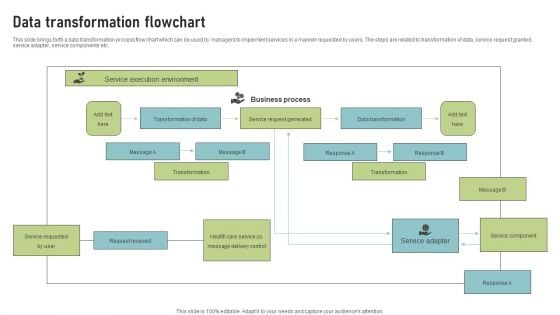
Data Transformation Flowchart Themes PDF
This slide brings forth a data transformation process flow chart which can be used by managers to implement services in a manner requested by users. The steps are related to transformation of data, service request granted, service adapter, service components etc. Persuade your audience using this Data Transformation Flowchart Themes PDF. This PPT design covers One stages, thus making it a great tool to use. It also caters to a variety of topics including Service Execution Environment, Business Process, Data Transformation. Download this PPT design now to present a convincing pitch that not only emphasizes the topic but also showcases your presentation skills.
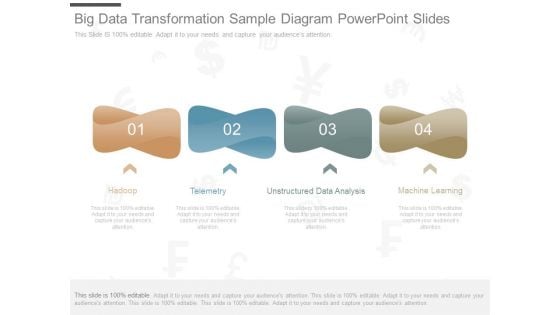
Big Data Transformation Sample Diagram Powerpoint Slides
This is a big data transformation sample diagram powerpoint slides. This is a four stage process. The stages in this process are hadoop, telemetry, unstructured data analysis, machine learning.
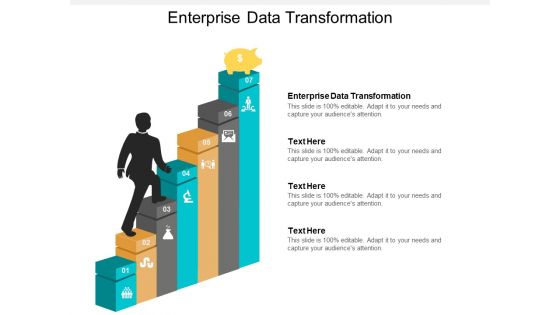
Enterprise Data Transformation Ppt PowerPoint Presentation Outline Example File Cpb
This is a enterprise data transformation ppt powerpoint presentation outline example file cpb. This is a seven stage process. The stages in this process are enterprise data transformation.
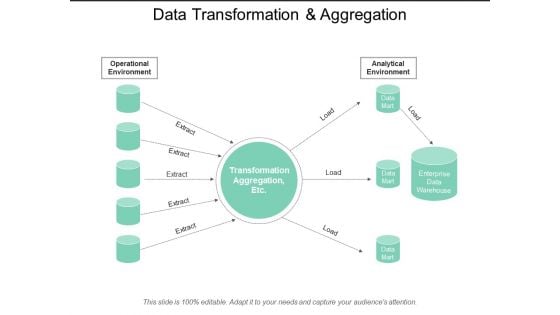
Data Transformation And Aggregation Ppt PowerPoint Presentation Model Ideas
This is a data transformation and aggregation ppt powerpoint presentation model ideas. This is a eight stage process. The stages in this process are transform and load, data wore housing, etl, extract.
Cloud Data Transformation Icon For Cloud Synchronization Rules PDF
Persuade your audience using this Cloud Data Transformation Icon For Cloud Synchronization Rules PDF. This PPT design covers three stages, thus making it a great tool to use. It also caters to a variety of topics including Cloud Data, Transformation, Cloud Synchronization. Download this PPT design now to present a convincing pitch that not only emphasizes the topic but also showcases your presentation skills.
Cloud Data Transformation Icon For File Conversion Rules PDF
Presenting Cloud Data Transformation Icon For File Conversion Rules PDF to dispense important information. This template comprises three stages. It also presents valuable insights into the topics including Cloud Data, Transformation, File Conversion. This is a completely customizable PowerPoint theme that can be put to use immediately. So, download it and address the topic impactfully.
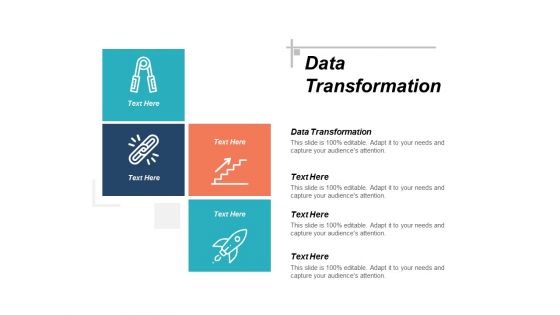
Data Transformation Ppt PowerPoint Presentation Ideas Vector Cpb
Presenting this set of slides with name data transformation ppt powerpoint presentation ideas vector cpb. This is an editable Powerpoint four stages graphic that deals with topics like data transformation to help convey your message better graphically. This product is a premium product available for immediate download and is 100 percent editable in Powerpoint. Download this now and use it in your presentations to impress your audience.
Organisational Data Transformation Strategy Icon With Arrows Sample PDF
Persuade your audience using this Organisational Data Transformation Strategy Icon With Arrows Sample PDF. This PPT design covers three stages, thus making it a great tool to use. It also caters to a variety of topics including Organizational Data Transformation Strategy Icon With Arrows. Download this PPT design now to present a convincing pitch that not only emphasizes the topic but also showcases your presentation skills.
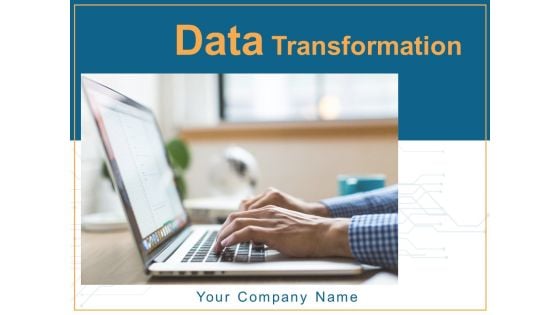
Data Transformation Ppt PowerPoint Presentation Complete Deck With Slides
Presenting this set of slides with name data transformation ppt powerpoint presentation complete deck with slides. The topics discussed in these slides are analysis stage, development stage, process. This is a completely editable PowerPoint presentation and is available for immediate download. Download now and impress your audience.
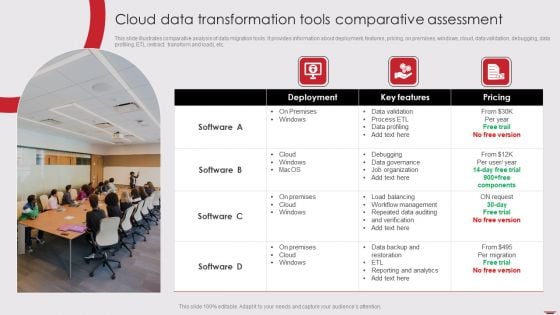
Cloud Data Transformation Tools Comparative Assessment Microsoft PDF
This slide illustrates comparative analysis of data migration tools. It provides information about deployment, features, pricing, on premises, windows, cloud, data validation, debugging, data profiling, ETL extract, transform and load, etc. Presenting Cloud Data Transformation Tools Comparative Assessment Microsoft PDF to dispense important information. This template comprises three stages. It also presents valuable insights into the topics including Deployment, Key Features, Pricing. This is a completely customizable PowerPoint theme that can be put to use immediately. So, download it and address the topic impactfully.
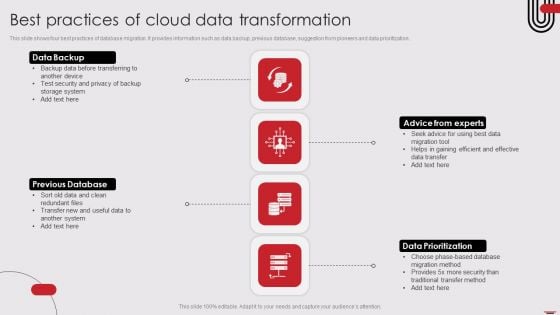
Best Practices Of Cloud Data Transformation Elements PDF
This slide shows four best practices of database migration. It provides information such as data backup, previous database, suggestion from pioneers and data prioritization. Presenting Best Practices Of Cloud Data Transformation Elements PDF to dispense important information. This template comprises four stages. It also presents valuable insights into the topics including Data Backup, Advice From Experts, Previous Database. This is a completely customizable PowerPoint theme that can be put to use immediately. So, download it and address the topic impactfully.
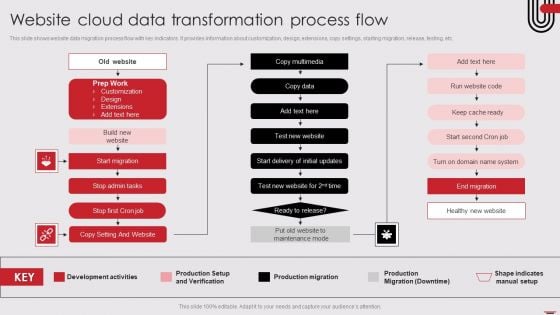
Website Cloud Data Transformation Process Flow Elements PDF
This slide shows website data migration process flow with key indicators. It provides information about customization, design, extensions, copy settings, starting migration, release, testing, etc. Showcasing this set of slides titled Website Cloud Data Transformation Process Flow Elements PDF. The topics addressed in these templates are Prep Work, Start Migration, Stop Admin Tasks. All the content presented in this PPT design is completely editable. Download it and make adjustments in color, background, font etc. as per your unique business setting.
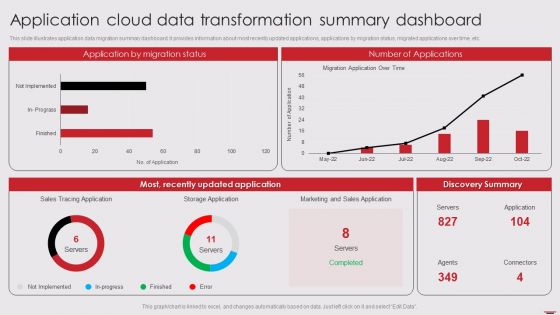
Application Cloud Data Transformation Summary Dashboard Mockup PDF
This slide illustrates application data migration summary dashboard. It provides information about most recently updated applications, applications by migration status, migrated applications over time, etc. Showcasing this set of slides titled Application Cloud Data Transformation Summary Dashboard Mockup PDF. The topics addressed in these templates are Application Migration Status, Number Applications, Most Recently Updated. All the content presented in this PPT design is completely editable. Download it and make adjustments in color, background, font etc. as per your unique business setting.
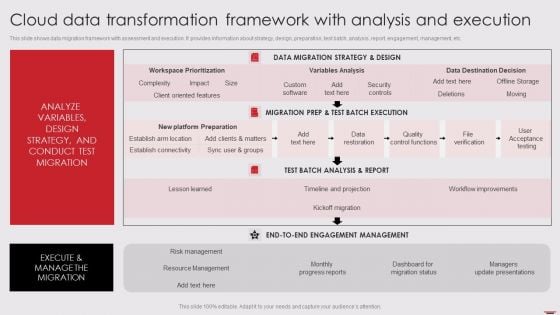
Cloud Data Transformation Framework With Analysis And Execution Diagrams PDF
This slide shows data migration framework with assessment and execution. It provides information about strategy, design, preparation, test batch, analysis, report, engagement, management, etc. Pitch your topic with ease and precision using this Cloud Data Transformation Framework With Analysis And Execution Diagrams PDF. This layout presents information on Data Migration Strategy, Migration Prep Test, Test Batch Analysis. It is also available for immediate download and adjustment. So, changes can be made in the color, design, graphics or any other component to create a unique layout.
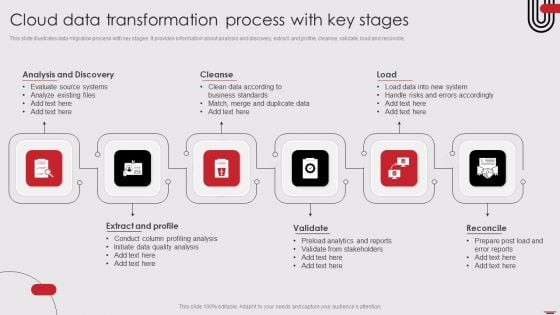
Cloud Data Transformation Process With Key Stages Microsoft PDF
This slide illustrates data migration process with key stages. It provides information about analysis and discovery, extract and profile, cleanse, validate, load and reconcile. Persuade your audience using this Cloud Data Transformation Process With Key Stages Microsoft PDF. This PPT design covers six stages, thus making it a great tool to use. It also caters to a variety of topics including Analysis Discovery, Cleanse, Load. Download this PPT design now to present a convincing pitch that not only emphasizes the topic but also showcases your presentation skills.
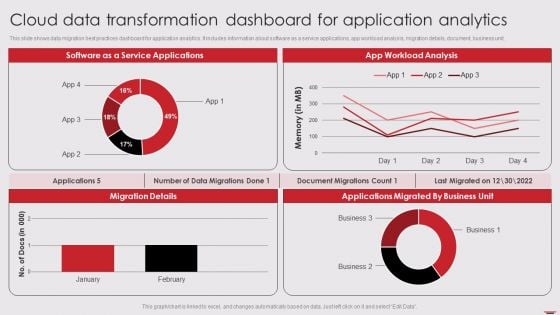
Cloud Data Transformation Dashboard For Application Analytics Information PDF
This slide shows data migration best practices dashboard for application analytics. It includes information about software as a service applications, app workload analysis, migration details, document, business unit. Pitch your topic with ease and precision using this Cloud Data Transformation Dashboard For Application Analytics Information PDF. This layout presents information on Software Service Applications, App Workload Analysis, Migration Details. It is also available for immediate download and adjustment. So, changes can be made in the color, design, graphics or any other component to create a unique layout.
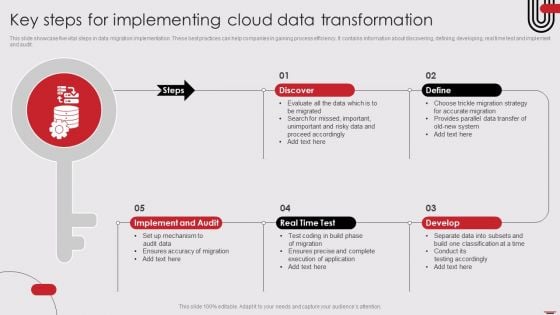
Key Steps For Implementing Cloud Data Transformation Designs PDF
This slide showcase five vital steps in data migration implementation. These best practices can help companies in gaining process efficiency. It contains information about discovering, defining, developing, real time test and implement and audit. Pitch your topic with ease and precision using this Key Steps For Implementing Cloud Data Transformation Designs PDF. This layout presents information on Discover, Define, Develop. It is also available for immediate download and adjustment. So, changes can be made in the color, design, graphics or any other component to create a unique layout.
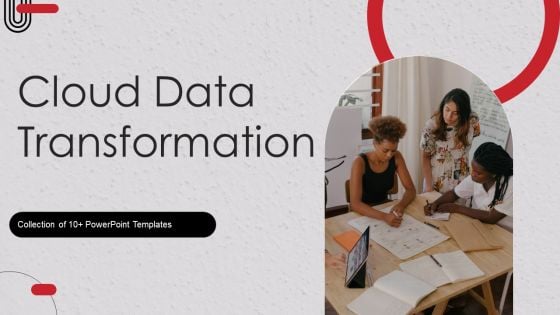
Cloud Data Transformation Ppt PowerPoint Presentation Complete Deck With Slides
If designing a presentation takes a lot of your time and resources and you are looking for a better alternative, then this Cloud Data Transformation Ppt PowerPoint Presentation Complete Deck With Slides is the right fit for you. This is a prefabricated set that can help you deliver a great presentation on the topic. All the thirteen slides included in this sample template can be used to present a birds-eye view of the topic. These slides are also fully editable, giving you enough freedom to add specific details to make this layout more suited to your business setting. Apart from the content, all other elements like color, design, theme are also replaceable and editable. This helps in designing a variety of presentations with a single layout. Not only this, you can use this PPT design in formats like PDF, PNG, and JPG once downloaded. Therefore, without any further ado, download and utilize this sample presentation as per your liking.
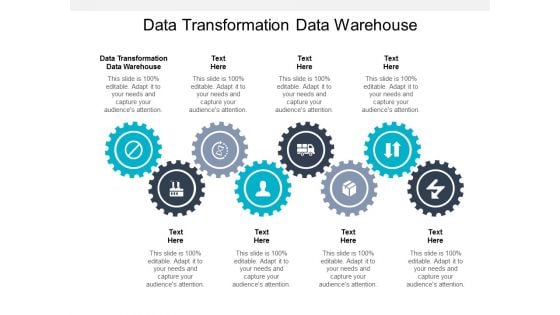
Data Transformation Data Warehouse Ppt PowerPoint Presentation Model Graphics Download Cpb
Presenting this set of slides with name data transformation data warehouse ppt powerpoint presentation model graphics download cpb. This is an editable Powerpoint eight stages graphic that deals with topics like data transformation data warehouse to help convey your message better graphically. This product is a premium product available for immediate download and is 100 percent editable in Powerpoint. Download this now and use it in your presentations to impress your audience.
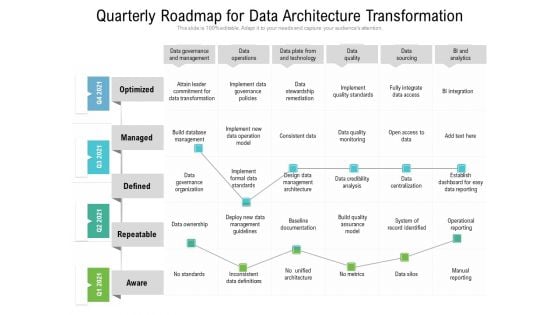
Quarterly Roadmap For Data Architecture Transformation Sample
Introducing our quarterly roadmap for data architecture transformation sample. This PPT presentation is Google Slides compatible, therefore, you can share it easily with the collaborators for measuring the progress. Also, the presentation is available in both standard screen and widescreen aspect ratios. So edit the template design by modifying the font size, font type, color, and shapes as per your requirements. As this PPT design is fully editable it can be presented in PDF, JPG and PNG formats.
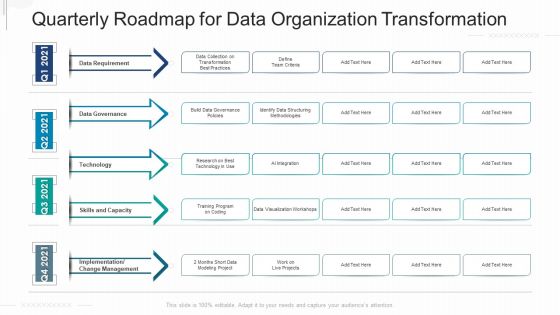
Quarterly Roadmap For Data Organization Transformation Designs
Introducing our quarterly roadmap for data organization transformation designs. This PPT presentation is Google Slides compatible, therefore, you can share it easily with the collaborators for measuring the progress. Also, the presentation is available in both standard screen and widescreen aspect ratios. So edit the template design by modifying the font size, font type, color, and shapes as per your requirements. As this PPT design is fully editable it can be presented in PDF, JPG and PNG formats.
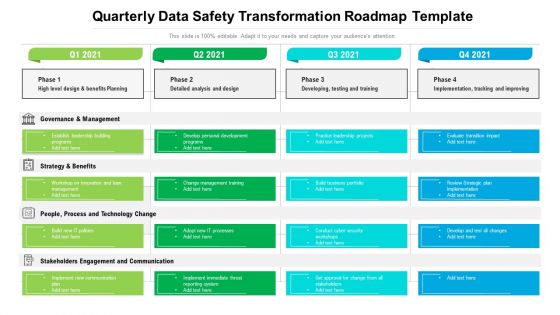
Quarterly Data Safety Transformation Roadmap Template Ideas
Presenting the quarterly data safety transformation roadmap template ideas. The template includes a roadmap that can be used to initiate a strategic plan. Not only this, the PowerPoint slideshow is completely editable and you can effortlessly modify the font size, font type, and shapes according to your needs. This PPT slide can be easily reached in standard screen and widescreen aspect ratios. The set is also available in various formats like PDF, PNG, and JPG. So download and use it multiple times as per your knowledge.
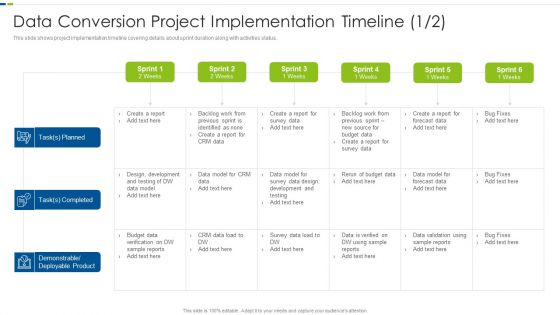
Utilizing Agile Methodology In Data Transformation Project IT Data Conversion Project Implementation Diagrams PDF
This slide shows project implementation timeline covering details about sprint duration along with activities status. Deliver and pitch your topic in the best possible manner with this utilizing agile methodology in data transformation project it data conversion project implementation diagrams pdf. Use them to share invaluable insights on planned, budget, survey data, development, design and impress your audience. This template can be altered and modified as per your expectations. So, grab it now.
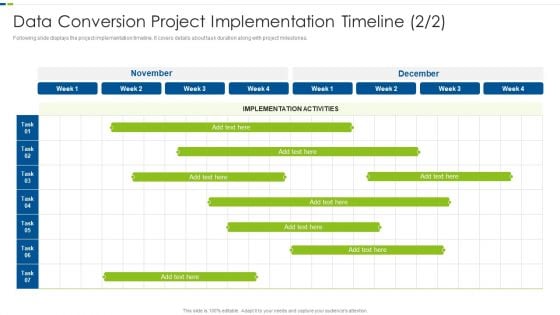
Utilizing Agile Methodology In Data Transformation Project IT Data Conversion Project Themes PDF
Following slide displays the project implementation timeline. It covers details about task duration along with project milestones. Deliver an awe inspiring pitch with this creative utilizing agile methodology in data transformation project it data conversion project themes pdf bundle. Topics like data conversion project implementation timeline can be discussed with this completely editable template. It is available for immediate download depending on the needs and requirements of the user.
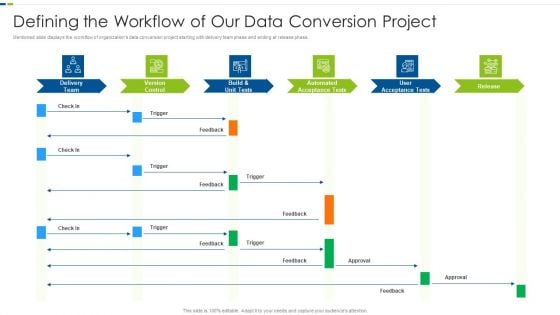
Utilizing Agile Methodology In Data Transformation Project IT Defining The Workflow Of Our Data Mockup PDF
Mentioned slide displays the workflow of organizations data conversion project starting with delivery team phase and ending at release phase. Deliver an awe inspiring pitch with this creative utilizing agile methodology in data transformation project it defining the workflow of our data mockup pdf bundle. Topics like defining the workflow of our data conversion project can be discussed with this completely editable template. It is available for immediate download depending on the needs and requirements of the user.
Data Transformation Goals With Icons Ppt PowerPoint Presentation Design Templates PDF
Presenting data transformation goals with icons ppt powerpoint presentation design templates pdf to dispense important information. This template comprises four stages. It also presents valuable insights into the topics including implementation commonly, data transformation, techniques, business transformation, analyse constant need, data transformation in business, analysing additive and multiplicative effects, data transformation, anova and regression, business model. This is a completely customizable PowerPoint theme that can be put to use immediately. So, download it and address the topic impactfully.
Company Data Transformation Strategy Icon With Statistics Ppt Show Visual Aids PDF
Presenting Company Data Transformation Strategy Icon With Statistics Ppt Show Visual Aids PDF to dispense important information. This template comprises three stages. It also presents valuable insights into the topics including Company Data Transformation, Strategy Icon, Statistics. This is a completely customizable PowerPoint theme that can be put to use immediately. So, download it and address the topic impactfully.
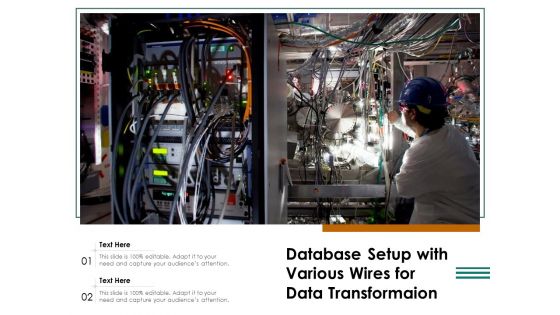
Database Setup With Various Wires For Data Transformation Ppt PowerPoint Presentation Layouts Inspiration PDF
Presenting this set of slides with name database setup with various wires for data transformation ppt powerpoint presentation layouts inspiration pdf. The topics discussed in these slide is database setup with various wires for data transformation. This is a completely editable PowerPoint presentation and is available for immediate download. Download now and impress your audience.
Data Transformation Process With Gear Wheel Icon Ppt PowerPoint Presentation Icon Background Images PDF
Presenting this set of slides with name data transformation process with gear wheel icon ppt powerpoint presentation icon background images pdf. This is a three stage process. The stages in this process are data transformation process with gear wheel icon. This is a completely editable PowerPoint presentation and is available for immediate download. Download now and impress your audience.
Data Transformation Cloud Computing Vector Icon Ppt PowerPoint Presentation File Example PDF
Persuade your audience using this data transformation cloud computing vector icon ppt powerpoint presentation file example pdf. This PPT design covers three stages, thus making it a great tool to use. It also caters to a variety of topics including data transformation cloud computing vector icon. Download this PPT design now to present a convincing pitch that not only emphasizes the topic but also showcases your presentation skills.
Data Transformation Shift Icon With Wheel Ppt PowerPoint Presentation Outline PDF
Persuade your audience using this Data Transformation Shift Icon With Wheel Ppt PowerPoint Presentation Outline PDF. This PPT design covers three stages, thus making it a great tool to use. It also caters to a variety of topics including Data Transformation, Shift Icon With Wheel. Download this PPT design now to present a convincing pitch that not only emphasizes the topic but also showcases your presentation skills.
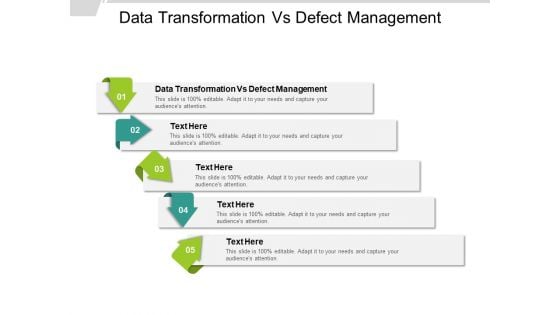
Data Transformation Vs Defect Management Ppt PowerPoint Presentation Show Display Cpb
Presenting this set of slides with name data transformation vs defect management ppt powerpoint presentation show display cpb. This is an editable Powerpoint five stages graphic that deals with topics like data transformation vs defect management to help convey your message better graphically. This product is a premium product available for immediate download and is 100 percent editable in Powerpoint. Download this now and use it in your presentations to impress your audience.
Data Transformation Process Vector Icon Ppt PowerPoint Presentation File Inspiration PDF
Persuade your audience using this data transformation process vector icon ppt powerpoint presentation file inspiration pdf. This PPT design covers three stages, thus making it a great tool to use. It also caters to a variety of topics including data transformation process vector icon. Download this PPT design now to present a convincing pitch that not only emphasizes the topic but also showcases your presentation skills.
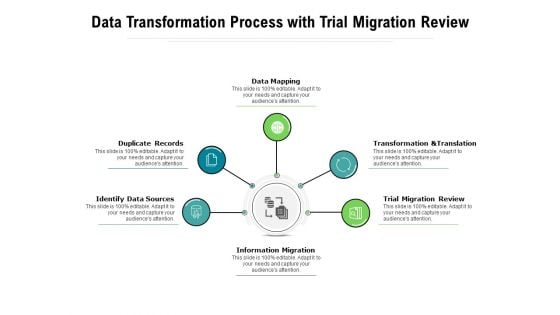
Data Transformation Process With Trial Migration Review Ppt PowerPoint Presentation Gallery Influencers PDF
Presenting data transformation process with trial migration review ppt powerpoint presentation gallery influencers pdf to dispense important information. This template comprises five stages. It also presents valuable insights into the topics including sources, migration, transformation. This is a completely customizable PowerPoint theme that can be put to use immediately. So, download it and address the topic impactfully.
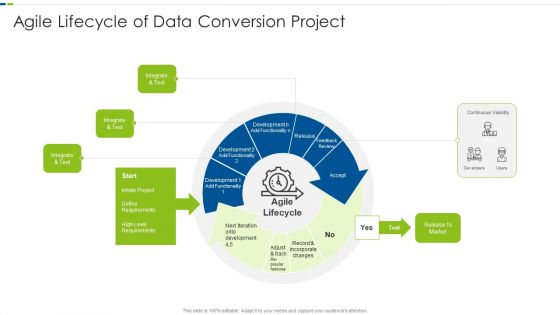
Utilizing Agile Methodology In Data Transformation Project IT Agile Lifecycle Formats PDF
Deliver an awe inspiring pitch with this creative utilizing agile methodology in data transformation project it agile lifecycle formats pdf bundle. Topics like agile lifecycle of data conversion project can be discussed with this completely editable template. It is available for immediate download depending on the needs and requirements of the user.
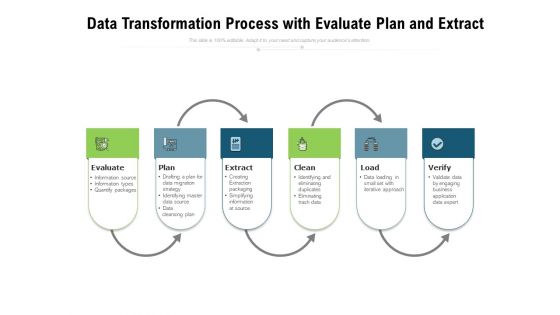
Data Transformation Process With Evaluate Plan And Extract Ppt PowerPoint Presentation File Grid PDF
Presenting data transformation process with evaluate plan and extract ppt powerpoint presentation file grid pdf to dispense important information. This template comprises six stages. It also presents valuable insights into the topics including evaluate, plan, extract. This is a completely customizable PowerPoint theme that can be put to use immediately. So, download it and address the topic impactfully.
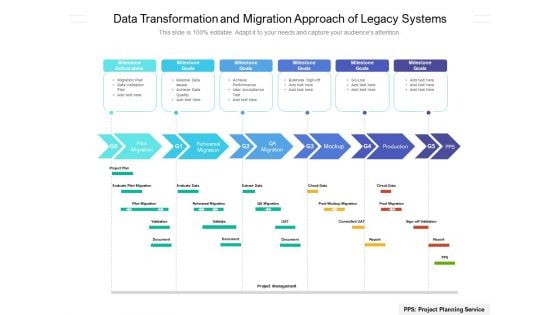
Data Transformation And Migration Approach Of Legacy Systems Ppt PowerPoint Presentation File Gridlines PDF
Presenting this set of slides with name data transformation and migration approach of legacy systems ppt powerpoint presentation file gridlines pdf. The topics discussed in these slides are evaluate, migration, validation. This is a completely editable PowerPoint presentation and is available for immediate download. Download now and impress your audience.
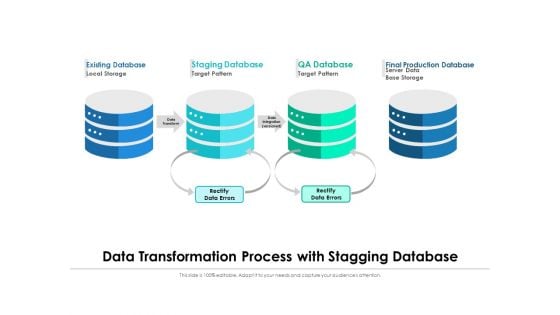
Data Transformation Process With Stagging Database Ppt PowerPoint Presentation File Visual Aids PDF
Showcasing this set of slides titled data transformation process with stagging database ppt powerpoint presentation file visual aids pdf. The topics addressed in these templates are target, server, integration. All the content presented in this PPT design is completely editable. Download it and make adjustments in color, background, font etc. as per your unique business setting.
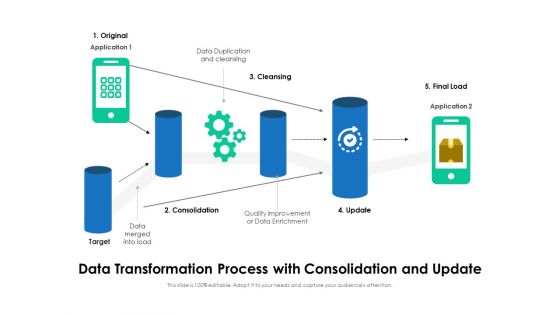
Data Transformation Process With Consolidation And Update Ppt PowerPoint Presentation Gallery Information PDF
Presenting data transformation process with consolidation and update ppt powerpoint presentation gallery information pdf to dispense important information. This template comprises five stages. It also presents valuable insights into the topics including consolidation, target, improvement. This is a completely customizable PowerPoint theme that can be put to use immediately. So, download it and address the topic impactfully.
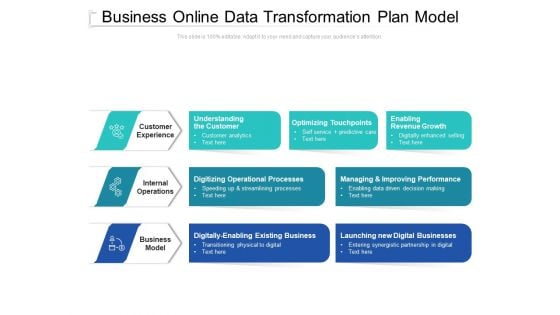
Business Online Data Transformation Plan Model Ppt PowerPoint Presentation Gallery Images PDF
Presenting this set of slides with name business online data transformation plan model ppt powerpoint presentation gallery images pdf. This is a three stage process. The stages in this process are customer experience, internal operations, business model. This is a completely editable PowerPoint presentation and is available for immediate download. Download now and impress your audience.
Icons Slide For Utilizing Agile Methodology In Data Transformation Project IT Elements PDF
Presenting our innovatively structured icons slide for utilizing agile methodology in data transformation project it elements pdf set of slides. The slides contain a hundred percent editable icons. You can replace these icons without any inconvenience. Therefore, pick this set of slides and create a striking presentation.

Utilizing Agile Methodology In Data Transformation Project IT What Will Be The Project Themes PDF
This slide displays organizations data conversion project structure which is categorized into three stages namely data, documents and coding. Deliver an awe inspiring pitch with this creative utilizing agile methodology in data transformation project it what will be the project themes pdf bundle. Topics like data quality, optimization, data report, project documents can be discussed with this completely editable template. It is available for immediate download depending on the needs and requirements of the user.
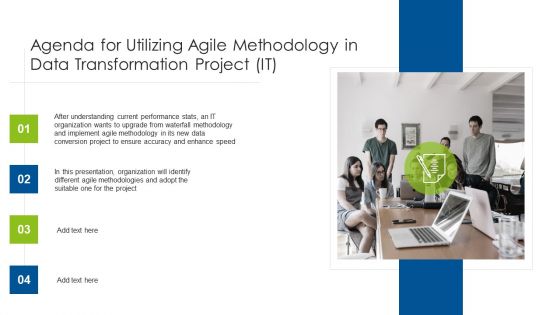
Agenda For Utilizing Agile Methodology In Data Transformation Project IT Ideas PDF
This is a agenda for utilizing agile methodology in data transformation project it ideas pdf template with various stages. Focus and dispense information on four stages using this creative set, that comes with editable features. It contains large content boxes to add your information on topics like features engineering, model training, model evaluation, data source, environment. You can also showcase facts, figures, and other relevant content using this PPT layout. Grab it now.
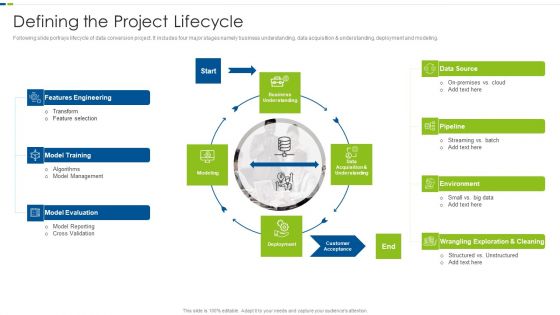
Utilizing Agile Methodology In Data Transformation Project IT Defining The Project Lifecycle Sample PDF
Presenting utilizing agile methodology in data transformation project it defining the project lifecycle sample pdf to provide visual cues and insights. Share and navigate important information on four stages that need your due attention. This template can be used to pitch topics like features engineering, model training, model evaluation, data source, environment. In addtion, this PPT design contains high resolution images, graphics, etc, that are easily editable and available for immediate download.
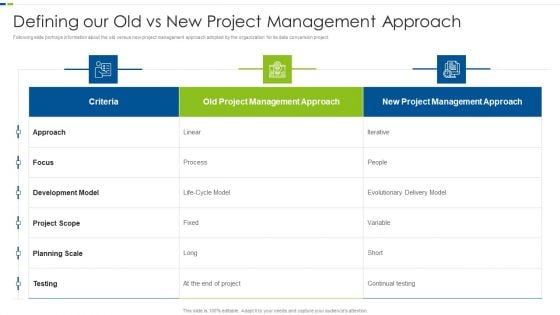
Utilizing Agile Methodology In Data Transformation Project IT Defining Our Old Vs New Project Template PDF
Following slide portrays information about the old versus new project management approach adopted by the organization for its data conversion project. Deliver an awe inspiring pitch with this creative utilizing agile methodology in data transformation project it defining our old vs new project template pdf bundle. Topics like development model, project scope, planning scale, management can be discussed with this completely editable template. It is available for immediate download depending on the needs and requirements of the user.
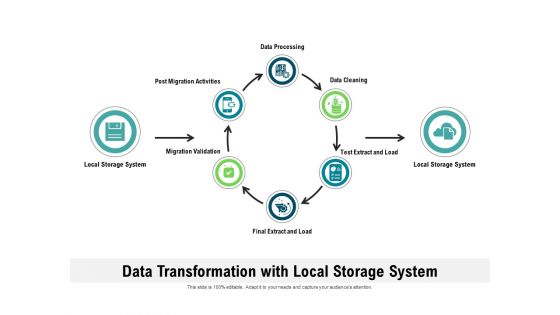
Data Transformation With Local Storage System Ppt PowerPoint Presentation File Infographics PDF
Persuade your audience using this data transformation with local storage system ppt powerpoint presentation file infographics pdf. This PPT design covers six stages, thus making it a great tool to use. It also caters to a variety of topics including validation, processing, migration. Download this PPT design now to present a convincing pitch that not only emphasizes the topic but also showcases your presentation skills.
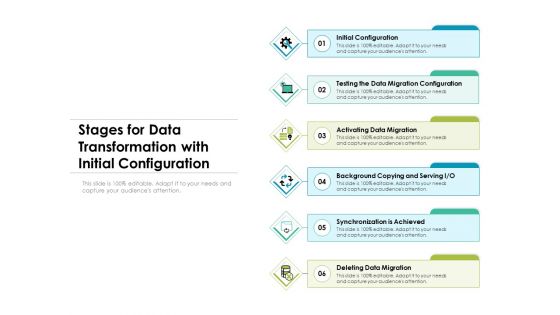
Stages For Data Transformation With Initial Configuration Ppt PowerPoint Presentation Gallery Inspiration PDF
Persuade your audience using this stages for data transformation with initial configuration ppt powerpoint presentation gallery inspiration pdf. This PPT design covers six stages, thus making it a great tool to use. It also caters to a variety of topics including migration, initial, synchronization. Download this PPT design now to present a convincing pitch that not only emphasizes the topic but also showcases your presentation skills.
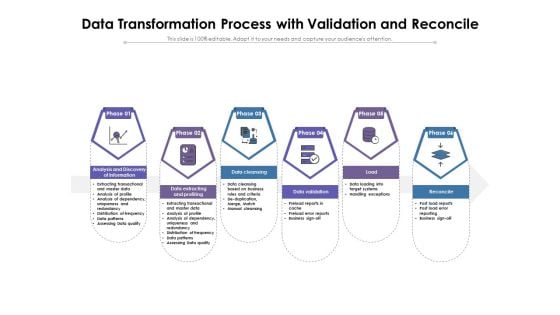
Data Transformation Process With Validation And Reconcile Ppt PowerPoint Presentation File Background PDF
Persuade your audience using this data transformation process with validation and reconcile ppt powerpoint presentation file background pdf. This PPT design covers six stages, thus making it a great tool to use. It also caters to a variety of topics including analysis, validation, extracting. Download this PPT design now to present a convincing pitch that not only emphasizes the topic but also showcases your presentation skills.
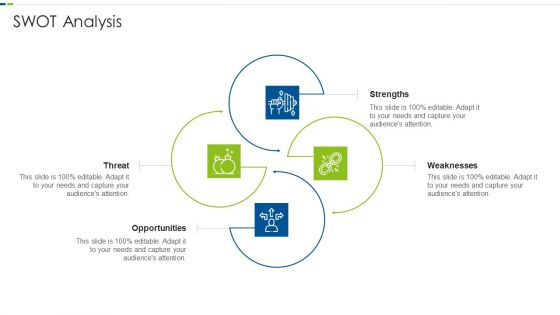
Utilizing Agile Methodology In Data Transformation Project IT SWOT Analysis Clipart PDF
This is a utilizing agile methodology in data transformation project it swot analysis clipart pdf template with various stages. Focus and dispense information on four stages using this creative set, that comes with editable features. It contains large content boxes to add your information on topics like strengths, weaknesses, threat, opportunities. You can also showcase facts, figures, and other relevant content using this PPT layout. Grab it now.
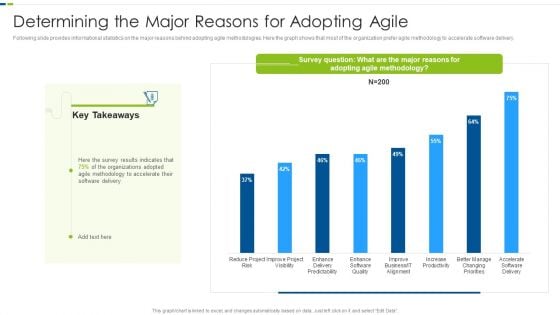
Utilizing Agile Methodology In Data Transformation Project IT Determining The Major Reasons Background PDF
Following slide provides informational statistics on the major reasons behind adopting agile methodologies. Here the graph shows that most of the organization prefer agile methodology to accelerate software delivery. Deliver an awe inspiring pitch with this creative utilizing agile methodology in data transformation project it determining the major reasons background pdf bundle. Topics like organizations, methodology can be discussed with this completely editable template. It is available for immediate download depending on the needs and requirements of the user.
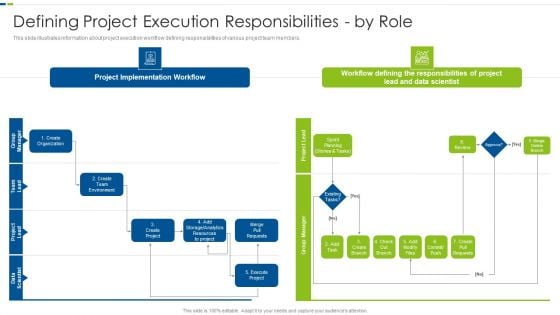
Utilizing Agile Methodology In Data Transformation Project IT Defining Project Execution Themes PDF
This slide illustrates information about project execution workflow defining responsibilities of various project team members. Deliver and pitch your topic in the best possible manner with this utilizing agile methodology in data transformation project it defining project execution themes pdf. Use them to share invaluable insights on project implementation, planning, environment, team and impress your audience. This template can be altered and modified as per your expectations. So, grab it now.
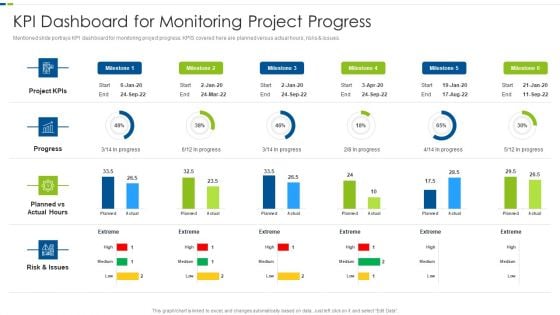
Utilizing Agile Methodology In Data Transformation Project IT KPI Dashboard For Monitoring Template PDF
Mentioned slide portrays KPI dashboard for monitoring project progress. KPIS covered here are planned versus actual hours, risks and issues. Deliver and pitch your topic in the best possible manner with this utilizing agile methodology in data transformation project it kpi dashboard for monitoring template pdf. Use them to share invaluable insights on risk, planned, project and impress your audience. This template can be altered and modified as per your expectations. So, grab it now.
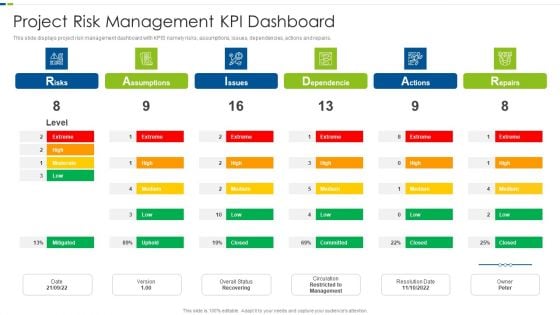
Utilizing Agile Methodology In Data Transformation Project IT Project Risk Management KPI Infographics PDF
This slide displays project risk management dashboard with KPIS namely risks, assumptions, issues, dependencies, actions and repairs. Deliver and pitch your topic in the best possible manner with this utilizing agile methodology in data transformation project it project risk management kpi infographics pdf. Use them to share invaluable insights on project risk management kpi dashboard and impress your audience. This template can be altered and modified as per your expectations. So, grab it now.
Cloud Data Transformation Dashboard Indicating Project And Provision Status Formats PDF
This slide showcase data migration best practices dashboard indicating overall project and provision status. It contains information about contains user, group and resource provision status. Showcasing this set of slides titled Cloud Data Transformation Dashboard Indicating Project And Provision Status Formats PDF. The topics addressed in these templates are Data Migration Status, Overall Project Status, Group Provision Status. All the content presented in this PPT design is completely editable. Download it and make adjustments in color, background, font etc. as per your unique business setting.

Utilizing Agile Methodology In Data Transformation Project IT Average Cost And Schedule Sample PDF
This slide portrays informational stats about the average cost and schedule overrun faced by the organization while completing its IT projects. Here the slide shows that on an average organization bears 55 percentage cost overrun. Deliver and pitch your topic in the best possible manner with this utilizing agile methodology in data transformation project it average cost and schedule sample pdf. Use them to share invaluable insights on organization, average, team, management, project and impress your audience. This template can be altered and modified as per your expectations. So, grab it now.

Utilizing Agile Methodology In Data Transformation Project IT Determining The OTD Rate Rules PDF
Mentioned slide provides information on the on time delivery rate of the IT projects completed by the organization. Here the stats indicates that OTD rate of IT projects completed in H1 of 2020 was 50 percentage. Deliver an awe inspiring pitch with this creative utilizing agile methodology in data transformation project it determining the otd rate rules pdf bundle. Topics like projects, organization, customer can be discussed with this completely editable template. It is available for immediate download depending on the needs and requirements of the user.

Utilizing Agile Methodology In Data Transformation Project IT Benefits Of Introducing Agile Designs PDF
This slide provides information on the benefits that organization will get after adopting agile methodology. Benefits covered are effective communication, transparency, improved quality and customer satisfaction. This is a utilizing agile methodology in data transformation project it benefits of introducing agile designs pdf template with various stages. Focus and dispense information on six stages using this creative set, that comes with editable features. It contains large content boxes to add your information on topics like improved quality, improved project predictability, understanding of customer needs, customer satisfaction, transparency. You can also showcase facts, figures, and other relevant content using this PPT layout. Grab it now.

Utilizing Agile Methodology In Data Transformation Project IT Details About Project Infographics PDF
Mentioned slide provides information about project context, project manager, key activities, duration and location. It also provides information on project objective and its scope in details. Presenting utilizing agile methodology in data transformation project it details about project infographics pdf to provide visual cues and insights. Share and navigate important information on six stages that need your due attention. This template can be used to pitch topics like project objectives, project deliverables, key activities and milestones. In addtion, this PPT design contains high resolution images, graphics, etc, that are easily editable and available for immediate download.

Utilizing Agile Methodology In Data Transformation Project IT Ppt PowerPoint Presentation Complete With Slides
Induce strategic thinking by presenting this complete deck. Enthrall your audience by deploying this thought provoking PPT deck. It can be downloaded in both standard and widescreen aspect ratios, thus making it a complete package to use and deploy. Convey your thoughts and actions using the fifty two slides presented in this complete deck. Additionally, feel free to alter its components like color, graphics, design, etc, to create a great first impression. Grab it now by clicking on the download button below.
Data Transform Machine Learning Introduction Exploring Machine Learning Operations Icons Pdf
This slide highlights the importance of data transform. The purpose of this slide is to explain how data transform is improving the accuracy and effectiveness of machine learning models. Want to ace your presentation in front of a live audience Our Data Transform Machine Learning Introduction Exploring Machine Learning Operations Icons Pdf can help you do that by engaging all the users towards you. Slidegeeks experts have put their efforts and expertise into creating these impeccable powerpoint presentations so that you can communicate your ideas clearly. Moreover, all the templates are customizable, and easy to edit and downloadable. Use these for both personal and commercial use. This slide highlights the importance of data transform. The purpose of this slide is to explain how data transform is improving the accuracy and effectiveness of machine learning models.

IMAGES
VIDEO
COMMENTS
What is Data Transformation? Data Transformation refers to the process of converting the format or structure of a data set to match that of a target system. It involves cleaning, validating, and preparing data and is a critical stage of both the ETL and ELT processes. Data analysts, data engineers, and data scientists collaborate to execute ...
Data transformation is a process that involves understanding the data, mapping the data to a destination system, and running the processes to perform the transformation. Before performing data transformation, pre-processing the data might be required. Preprocessing data includes tasks like de-duplicating records, managing outliers, and imputing ...
Dec 3, 2023. 1. Data transformation plays a crucial role in data management. This process reshapes data into formats that are more conducive to analysis, unlocking its potential to inform and ...
Data transformation is the process of converting data from one format, such as a database file, XML document or Excel spreadsheet, into another. Transformations typically involve converting a raw data source into a cleansed, validated and ready-to-use format. Data transformation is crucial to data management processes that include data ...
What is Data Transformation? D ata Transformation in a statistics context means the application of a mathematical expression to each point in the data. In contrast, in a Data Engineering context ...
Data transformation refers to the process of converting, cleaning, and manipulating raw data into a structured format that is suitable for analysis or other data processing tasks. The last few decades have seen a renaissance in data collection and processing—today's data teams have more information at their disposal than ever before.
The first step of the data transformation process is to identify and collect the relevant datasets through data profiling. This includes understanding your source systems, clarifying what you need from them, and understanding the data structure. Your sources may include data from databases, spreadsheets, or other platforms.
Data transformation is an integral part of data management and analysis. It involves manipulating raw data to make it more meaningful and useful. By transforming data, organizations can enhance decision-making, improve operational efficiency, and gain valuable insights. One key aspect of data transformation is the process of data enrichment.
Data transformation: The foundation of analytics work. Data transformation is the process of taking raw source data and using SQL and Python to clean, join, aggregate, and implement business logic to create important datasets. These end datasets are often exposed in a business intelligence (BI) tool and form the backbone of data-driven business ...
The data transformation process manipulates datasets so they can be used by business data applications. It's critical for realizing value from raw data by generating insights that can be used to make business decisions. Transformation gives organizations the data they need to better understand the past, present and future of their business ...
Data transformation is the process of changing the format, structure, or values of data. For data analytics projects, data may be transformed at two stages of the data pipeline. Organizations that use on-premises data warehouses generally use an ETL (extract, transform, load) process, in which data transformation is the middle step.
What Is Data Transformation? Data transformation is the process of converting data from one format, structure, or set of values to another by way of joining, filtering, appending, or otherwise performing some sort of computation on the data. The data transformation process is managed within a data pipeline.
All teams within a company's structure benefit from data transformation, as low-quality unmanaged data can negatively impact all facets of business operations. Some additional benefits of data transformation include: Improved data organization and management. Increased computer and end-user accessibility. Enhanced data quality and reduced errors.
Data transformation plan PowerPoint complete deck is a systematic presentation which includes PPT slides such as data migration approach, steps, a simplified illustration of data migration steps, lifecycle, process, data migration on the cloud, and many more.
Data transformation is the process of taking data that exists in one format or state and converting it into a different format or state. Transformation is the middle step in the extract, transform, and load (ETL) process — and the final step in the extract, load, transform (ELT) process.
Understanding Data Transformation. The process of data transformation, involves converting, cleansing, and structuring data into a usable format which is used to analyzed to support decision-making processes. It includes modifying the format, organization, or values of data to prepare it for consumption by an application or for analysis.
Data Transformation Using SAS Data Mydata; input x; newx=log (x); newx=sqrt (x+3/8); newx=arsin (sqrt (x)); cards; Natural logarithm transfromation Square-root transformation Arcsine transformation. Data Transformation. Objectives: Understand why we often need to transform our data The three commonly used data transformation techniques Additive ...
Data transformations should always follow a fit-predict paradigm. Fit the transformer on the training data only. E.g. for a standard scaler: record the mean and standard deviation. Transform (e.g. scale) the training data, then train the learning model. Transform (e.g. scale) the test data, then evaluate the model.
The advantageous slides on Data Transformation Powerpoint Presentation Slides is braced with multiple charts and graphs, overviews, analysis templates agenda slides etc. to help boost important aspects of your presentation. Highlight all sorts of related usable templates for important considerations. Our deck finds applicability amongst all ...
Data transformation is the process of modifying data to fit a particular purpose or context. This can involve tasks such as cleaning, standardization, or aggregation, all aimed at enhancing data quality and usability for more accurate analysis. Transformed data, then, is the result of this process. It's data that's been reshaped from its ...
Data presentation is the art of transforming raw data into a visual format that's easy to understand and interpret. It's like turning numbers and statistics into a captivating story that your audience can quickly grasp. When done right, data presentation can be a game-changer, enabling you to convey complex information effectively.
Data Transformation.ppt. This document discusses data transformation techniques for statistical analysis. It explains that if measurement data is not normally distributed or has unequal variances, transformation is necessary. It then outlines steps to test for normality in SPSS. The document focuses on three common transformations: logarithmic ...
Data Quality Assurance: Ensuring data quality throughout the transformation process can be complex, especially when dealing with large, diverse datasets. Inaccurate or incomplete data can lead to ...
Presenting this set of slides with name data transformation ppt powerpoint presentation ideas vector cpb. This is an editable Powerpoint four stages graphic that deals with topics like data transformation to help convey your message better graphically. This product is a premium product available for immediate download and is 100 percent ...